| |
Return
to Top
War in Korea, the very first days of the Cold War in Germany and
a major concern that fighting could again erupt in central
Europe, this was the background to the end of the Constabulary
period and beginning of the U.S. Army surveillance mission on
the East-West border. Various squadron commanders and troopers
have stepped forward to recall the mission from their period at
Daley Barracks.
| |
|
|
|
|
| |
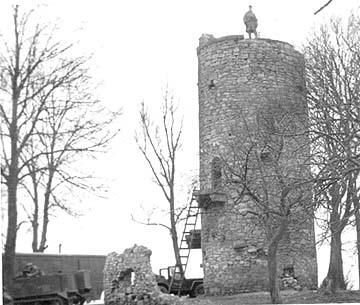
This is the tower by
Munnerstadt where we had our forward patrol base on the
border. It was about mid way along the route and also
served as a static OP. From here, two patrols went out
each day at various times, one to the north and one to
the south. Each patrol had a scout jeep and a machinegun
jeep. Upon return, a hot meal and maintenance. A camp
site had been established.
--LTC (Ret) Richard D. Moore |
|
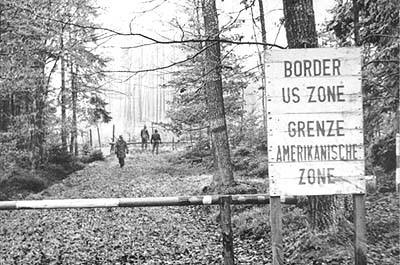
A typical border scene in
the woods, the areas were not well marked but at least
here, a wood barrier is set up as a warning along a
trail.
--LTC (Ret) Richard D. Moore |
|
| |
|
|
|
|
When the barrier fence was little more than barbed wire strung
along fence posts, the squadron was well aware of the Soviet
regiment in Meiningen and the "Meiningen Gap". While not a prime
avenue of attack to the West, it nevertheless was a corridor of
sufficient width to accommodate at least a secondary armor
thrust. Particularly after only a few kilometers into West
Germany, this avenue opened into broad, rolling farm land, ideal
for massed armor in the advance. The terrain ran all the way to
Bad Kissingen, Schweinfurt and Wurzberg / Frankfurt. The 2 - 14
ACR identified and staffed observation and listening points both
on the immediate border and in depth running southeast along
Highway 19.
Ed Keaney, Bobby Bush, CWO 4 (Ret) Jake Hulen, Robert Stauffer,
Edward Bowmann and LTC (Ret) Richard Moore recall the very early
days along the border.
Ed Keaney 1950-1953:
"I was there right at the beginning, the move from Schweinfurt
and the first days on the border. I had been with the scouts as
a sergeant and then Platoon Sergeant so I spent a lot of time on
the border. Two ham sandwiches in a bag and maybe a K Ration,
out the gate and off to the tower by Munnerstadt which was our
start point, turn on to the trail and have a good day! We would
patrol all the way down to Konigshofen and back. The border was
little more than a plowed strip and a few stakes, it was easy to
make a mistake. One jeep with a brand new radio was captured on
the DDR side, everyone and everything was returned within eight
hours .... except for that radio. I recall seeing the East
Germans and maybe Russians on the other side, one guy once aimed
his rifle at me but his patrol leader intervened. I think I left
a few cigarettes for that guy as we moved on."
| |
|
|
|
|
| |
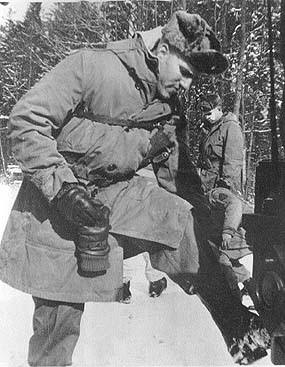
Here I am, 1Lt. Richard D.
Moore, 3rd Plt., Co. D in typical winter garb on the
border. This was the typical uniform, bunny hat, parka
and Mickey Mouse boots.
--LTC (Ret) Richard D. Moore |
|
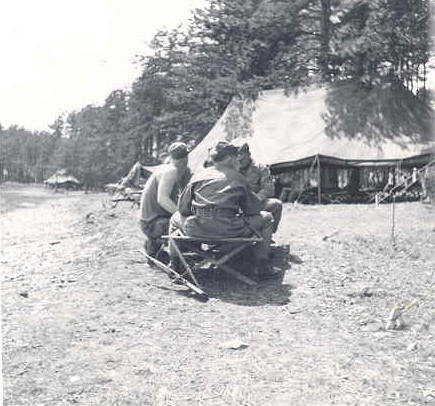
Here is the border camp by
the tower near Munnerstadt in 1951 or 52; time out for a
little card game.
--Ed Keaney |
|
| |
|
|
|
|
"I recall some incidents of gun fire on the border; maybe it was
hunters, maybe not .... I don't think the shots were aimed,
maybe just harassment. I remember we were short of officers in
the units, Korea had taken its toll on the units so sometimes
quality control was in rough shape. I am pretty sure that on
some of the cold snowy days, more than a few patrols were
checking out local bakeries. That wasn't too bad, checking out
the Gast houses and the bars .... well .... that's another
matter. We were not using Wollbach at the time, such as it was,
our patrol base was the tower by Munnerstadt."
Bobby Bush 1951-53:
"I was in the Tank Company and then Recon Company 'E' and
finally Headquarters Company during those early days in Bad
Kissingen. We took over the border responsibilities from one of
the Constabulary cavalry units as soon as we moved to Daley
Barracks. There still were sizable stretches of border with no
fences up, particularly in the woods. The East Germans and the
Russians were always seen working on getting the fences up in
the open fields and near the towns, the refugee problems, at
least in the border area seemed over."
"I recall the patrolling as being handled by a Recon Company
with a platoon of the Tank Company attached as the reaction
force. The only guys going out to the border were the scouts and
their accompanying machine gun jeeps. All this was done from the
barracks and the patrols sometimes lasted as long as 36 hours to
cover the allocated area. The area by Wollbach (he may have
meant Munnerstadt) evolved as a patrol base used during the
Summer for scouts to camp on the long missions. A radio relay
was also set up there on occasion."
CWO 4 (Ret) Jake Hulen 1951 - 1954:
“I was a platoon leader
with the 2-14 ACR in Germany from 1951 - 1954 and recall the
border mission. Something makes me think that two platoons were
sent to the Munnerstadt camp, one would take the north sector
and the other, the southern sector. Patrols were most often done
with jeeps, I cannot recall ever doing day light foot patrols.
The Munnerstadt camp was also our night listening post. In
addition to the jeep patrols, we would occasionally send out a
five man static observation post. The locations varied.”
| |
|
|
|
|
| |
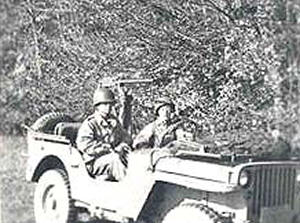
Machinegun jeep on the
border in the early 1950s.
--Ed Keaney |
|

A patrol gets ready to move
out on one of those rare warm days.
--Ed Keaney |
|
| |
|
|
|
|
“I think the ’reaction force’ for any trouble on the border
was located back at Daley Barracks and it makes sense that it
would be the third platoon in the recon company. I do not recall
taking the ½ tracks or tanks to Munnerstadt, I am sure that the
patrolling was done in jeeps alone. “
“I do not recall radio communications being much of a
problem. I don’t think the reports were real - time events
unless something really out of the ordinary was seen. My
recollection is that the men on patrol knew where the high
ground or clear avenues for radio communication were and would
keep the patrol base up to date when they felt sure the messages
would reach us.“
“My best border story, and all of this is a long time ago,
had to do with escorting a U.S. Senator up to the border. I
think he was from New Mexico and for some reason, wanted to take
a piss - over the line - into East Germany. Far be it from me to
get in the way, so we found a place and - he did it - while at
least to East German Volkspolitzei guards observed.“
“My other significant memory from those days was of racial
integration in the battalion. Those were, as they say,
interesting times in the Army. Battalion Commander LTC Spurrier
and then his successor, LTC Reynolds, were great leaders.
Training, maintenance and discipline were always top priorities.
After Germany, I was in the reserves for a while and then went
into the National Guard. I went to flight school, took a
position as a Flight Warrant Officer, went to Vietnam and then
spent many years either in uniform or as a civilian NG employee
doing flight training or maintenance. Finally retired from it
all as a CW 4 in 1989.“
| |
|
|
|
|
| |
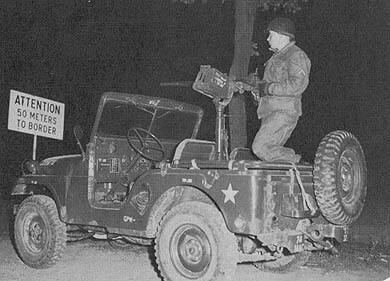
US Patrol on
the border, 1960. Stefanowicz |
|

The "2
Kilometer Warning sign" these signs were found on all
roads leading into the border area at the 2 kilometer
point. Commonly found during the 2/14 ACR patrol
period, by 1975, they had almost all been replaced with
the " 1 Kilometer to Border " signs. Tartella |
|
| |
|
|
|
|
Robert Stauffer 1954-55:
"We only used the scouts on the border, the tankers and mortar men
concentrated on training and maintenance. The infantry squad was used
as necessary to fill in if we were short. We often saw Russians on the
border, now and then we picked up stray East German civilians and
guards on our side. They were interrogated and returned. At least
once, US forces wandered across and a similar fate was in store for
them. Everyone was armed and shots were exchanged across the border.
We never started it, but we always responded. On the other hand, there
was one Russian I would see quite often right on the very border line.
He spoke English, we would chat and I think I even gave him a pack of
cigarettes. As a platoon leader, I tried to spend as much time on the
border during our turn as possible. We only used the radios to report
on things that seemed out of the normal pattern; everything else was
covered in an extensive debriefing once the patrol was completed."
"I recall our schedule as two weeks on the border, two weeks doing
maintenance and two weeks conducting classes and training. Alerts came
at any time of the day or night and often we were out for two or three
days on no notice. I don't think we expected a war but we took the
possibility very seriously."
Ed Bowmann:
"I was trained as a tank driver but soon was driving scout jeeps on
all the patrols, it seemed as though we went out for 24-36 hours each
time. We patrolled with the machine gun jeep in the day and set up a
listening post at night. Three 'C' rations was all you could expect
until we got back to the barracks or the tent camp by Wollbach ( maybe
Munnerstadt ) which I think we used in both Summer and Winter. One of
my strongest memories is just how rural the whole area was, farm land
and large woods in neatly set up blocks, you'd go through these tiny
German villages and maybe see one or two weak light bulbs in the
windows, the night sky was as dark and filled with stars as you could
ever imagine. You really felt as though you were way out ... there ."
LTC (ret) Richard Moore 1954-55:
"I don't recall the gun fire on the border but there certainly were
many gaps where soldiers could stray across by mistake. One patrol
strayed north into East Germany by three or four hundred meters once
and the Vopo's came tearing after them at high speed. I don't think
that particular US Patrol stopped heading south until they got to
Mellrichstadt! I was in Recon Company D in the early 1950s and
remember that there was an old stone tower by Munnerstadt that we used
as both an OP and a rally point for the patrols. The patrolling was
done primarily by the scouts but we rotated through other members of
the platoon as needed. I had to be careful with my drivers to insure
that the every vehicle could move out if an alert was called so that
always required a careful check as the assignments were made."
| |
|
|
|
|
| |
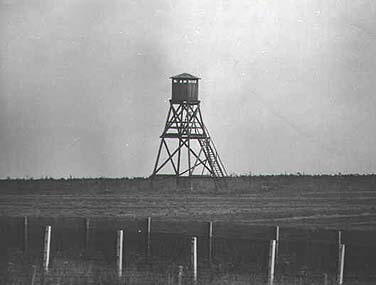
A wooden tower guarding
a 2nd generation barrier fence. This would have
been a normal scene during the 1960's as the 2/14
patrolled the border. Ritter |
|
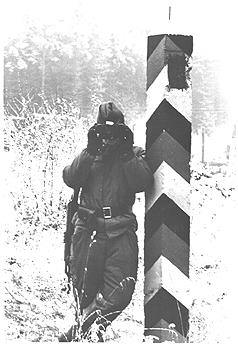
In 1967, a GAK checks
out the US patrol.
--Terry Sharp |
|
| |
|
|
|
|
As the border began to evolved into the full barrier system, the
casual patrolling to intercept smuggling and refugees of the old
Constabulary days gave way to a system of formal patrolling, fixed
observation posts and spot reports detailing East German activity. The
border observation mission became something that troopers of the
Eaglehorse squadron could clearly recognize but there were some
surprises.
Col (Ret) Curtis Rosler, LTC (Ret) Willard C. Copp and Robert E. Lied
collectively recall the border mission and the 2/14 ACR in the late
1950s and early 1960s.
"Much of the border was still open. There may have been some barrier
fence in the northern portion but the majority of our sector was
marked by both East and West Germany but there were no fences. Maybe
when the Berlin Wall started going up, the fence building picked up
speed."
"Our border camp was by Wollbach and it was no hotel but adequate.
There was a building that held our HQ, mess hall and radio room. There
was a troop billet and a generator building. All this was there when
we arrived so I guess it was put up in 1956-1957."
"The surveillance mission was performed by the scouts in their jeeps,
pulled from the three platoons and used as a consolidated group under
an Lt from the Troop. He was the OIC for the mission and I guess we
rotated the Lts, maybe ten days each. If additional men were needed,
we always had the infantry squads to draw from. The tankers and mortar
men remained in BK with the rest of the Troop. We had no fixed OPs
that can be recalled but there were many places we all knew that
provided good vantage points to observe the East or could be used as
listening posts at night. I think we were covering much of our sector
each day, perhaps two sets of two scout jeeps going both northwest and
southeast along the border. Much but not all of this occurred in the
daylight, I believe we maintained a pretty good presence at night, not
patrolling but in stationary positions. Spot reports were called in as
observations were made and these were relayed to Daley Barracks. Also,
the Squadron had one or two L19 aircraft that flew the border when
ever possible. The Lts from How Btry were trained ariel observers and
that was their contribution."
"Back in Bad Kissingen, we had a H34 type cargo helicopter from Fulda
stationed on the parade field with crew ready to go. This was the '
fast reaction force ' and it was staffed by an infantry squad from the
border Troop and an additional Lt. In the event of any sort of trouble
on the border, they were our initial response. They were called out
and inserted on occasion for training but I don't recall an actual
emergency alert. It was called the 'Howdy Doody squad'."
| |
|
|
|
|
| |
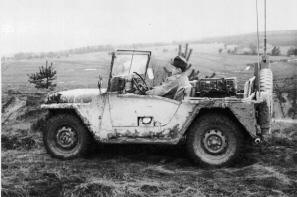
Jeep patrol on the
border.
--Richard Harrington |
|

OP 10 on the hill
looking towards the Meiningen Gap. The photo shows
just how small it was prior to the expansion in the
late 1960's.
--Richard Harrington |
|
| |
|
|
|
|
"There were a few 'illegal border crossings', and most times these
were picked up by the West Germans but once, an East German guard came
across to one of our patrols. That was a big deal for some time. On
occasion, we filled in at OP Alpha in the 1/14 sector when they were
committed to major training."
During most of this period, only Troops E, F and G conducted the
surveillance mission. H Company and How Battery were exempt but as the
mission demanded, on occasion, they sent entire platoons to the border
to assist. In early 1967, the 2/14 ACR was detached from the parent
regiment and attached to the 2 nd ACR. This situation remained until
the reflag to the 11th ACR and return to V Corps. Also during this
period, the squadron was responsible for a very long run of border,
extending from Frankenheim in the northwest to the junction of West
Germany, Austria and Czechoslovakia in the southeast.
Starting in 1966, the border mission was run from two camps, at
Wollbach and at Camp Harris, Coburg, with a reinforced platoon at the
each location; fixed OP's and jeep patrols kept watch. Wollbach was
basically a "rough and ready" area but under LTC Paul Palmer in 1966,
a more permanent camp was built. The next commander of the 2/14 ACR,
LTC John Byers, expanded the OP that watched the Meiningen Gap. The
building he left behind is what troopers of the Eaglehorse, a few
years later, would remember as OP Sierra. At some point also, the
brick OP we later remembered as OP 13 by Breitensee was built. Buses
rolled almost every weekend from Bad Kissingen to the border camps
carrying wives and children for reunions that lasted a few hours.
Col (Ret) Norman Harms, 2/14 commander in 1969-1970, recalled the
border much as his predecessors. The Army in Germany during the
Vietnam era was a very demanding assignment for all ranks. He
remembered border tours of six weeks per Troop with ample support from
HHT and H Company. The border to gunnery and immediately to major
maneuvers and then return to the border was not uncommon for a cavalry
troop. He noted,
"... but the best story I have concerning the border concerns those
trees by the OP on the hill. The trees and the brush were in the way
of the troops, that was clear to me. I tried on a few occasions to get
the local Germans to cut them back to improve our vision ... no luck!
So, as Post Commander, one day I just solved the problem. We had those
Combat Engineers at Daley, I got a group of them in trucks with chain
saws and sent them up to the OP. Couple of hours later, the tree and
bush problem was solved .... the Germans were not happy! So the
complaining started and even the VII Corps Commander came down to take
a look. He took me aside after the visit and said, ' I have money in
the budget for this sort of thing, trees and maneuver damage, we'll
smooth it over with the Germans, although I think in one day, you just
used half of what I have! Have to agree with you though .... you did
the right thing!'" .
| |
|
|
|
|
| |
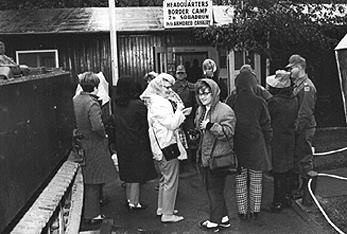
Family
day at Camp Wollbach once the more substantial camp
was built.
--Paul Palmer |
|
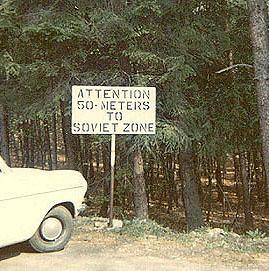
One of
the older style signs as of 1967 on the border; even
the East Germans objected to the wording.
--William Carlisle |
|
| |
|
|
|
|
MSG (Ret) Jack Stoltz:
"I was with the squadron from Feb 1969 until early 1973, first as a
Platoon Sergeant in Troop F and then as the Squadron Border NCO. Here
is how I remember it. The rotation was E, F and G only, the missions
on the border were done with the scouts and infantry squads primarily.
The tankers and mortar squad helped out as needed. I guess now and
then, some troopers from H Company may have come up to help but it was
a rarity. The standard patrol was done with the jeeps and we had the
block house OP by Highway 19. I remember we used the M113s as static
OPs quite often. The camp at Wollbach had not received any "newer"
barracks yet, it was still the Quonset Huts and they were adequate.
There was no "Beer Hall" during my period and we used the Mess Hall as
the movie theater at night. We did have a Camp Custodian looking after
the Camp."
"I recall five times when East German Border Guards or workers came
over. It was as they were putting in new mine fields and had the fence
line opened up. On four occasions, the BGS picked those guys up; they
usually had people on site monitoring all the big East German
projects. Once, one of our patrols found an East German guy and we
immediately turned him over to the BGS. That was an exciting day!"
"We did not have a big training program at Daley for the next Troop as
it got ready to go to Wollbach, that was left up to the Troop
Commander and his guys. The rotations came so fast, that even with the
turn over common in the Vietnam period, there were not too many new
troopers to familiarize with the border each time. As a Platoon
Sergeant, I always handled it ' in house '. Within 72 hours of the new
Troop assuming the mission, there would be a command inspection by the
SCO and myself. We would look as all aspects of the camp and the
mission to insure they were off to a good start. I was active on the
border for both quality control and working on missions that the S2
gave out and I was the observer on some of the border flights. We did
not have an "air insertion" patrol, however."
| |
|
|
|
|
| |
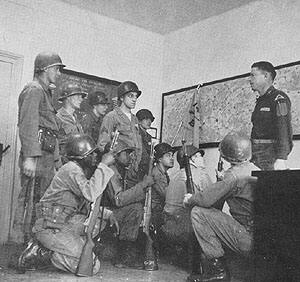
Scouts of
Recon Company 'E' receive the mission briefing prior
to departure from Daley Barracks.
--Stefanowicz |
|
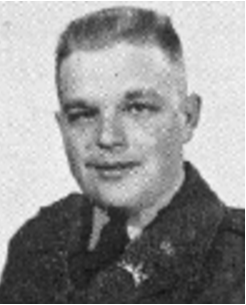
Lt Bob Stauffer, Recon Company
'F', in 1954.
--Stefanowicz |
|
| |
|
|
|
|
"The only times we used the camp at Coburg was when we filled in the
border patrol of the 2 nd ACR unit that had gone to Graf. That
happened maybe once or twice per year and when we had our rotation,
they came up to Camp Wollbach. In my career, I spent a lot of time in
border cavalry units, and I really enjoyed it and I think the troops
found the mission interesting."
BG (Ret) Mike O'Connell, squadron commander in 1972-73, remembers big
changes as the 14th ACR reflagged to the 11th ACR. At the camp, he was
able to get the support of the Regional Facilities Engineers to fully
winterize the buildings and with help from the VII Corps Commander,
LTG Mearns, found some funds for further improvements at the Beer
Hall. The tables and chairs were added, a donation from the local
German beer distributor and this may have been when beer was first
authorized. He also wanted an entire cavalry troop to be able to
occupy Camp Wollbach so plans were drafted to expand the hardstand.
The construction was underway as he changed command.
Col (Ret) Frank Hurd, the Troop G commander and S2 was with the
squadron from 1970-73 and witnessed the replacement of the older
Quonset hut barracks buildings at the camp with German manufactured
prefabricated buildings. The camp roads and track park were still
unpaved and a fire destroyed the wood frame motor shop building. It
was replaced with the cinder block two bay building that remains on
site to this day.
Great thanks to Col (Ret) Paul Palmer, Col (Ret) John Byers, Col (Ret)
Norman Harms, Col (Ret) Frank Hurd, BG (Ret) Mike O'Connell, MSG (Ret)
Jack Stoltz and all the other members of the 2/14 ACR for helping us
tell this story.
| |
|
|
|
|
| |

PFC Ed Bowmann in 1954.
--Stefanowicz |
|
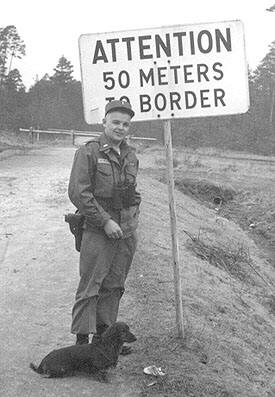
Lt Stauffer and 'patrol Dachshund'
on the border in 1954 having a little bit of fun
while we did a serious job. After seeing all those
huge German guard dogs on both sides of the border,
I couldn't resist this photo.
--Bob Stauffer |
|
| |
|
|
|
|
|
|
| |
The
Border Mission 1972-1973 |
|
| |
Return to Top
BG (Ret) Mike O'Connell:
"When I took command of
the squadron, we were still part of VII Corps and attached
to the 2nd ACR. The mission was conducted out of both
Wollbach and Coburg and we were responsible for a very long
run of border. This was a difficult task, the mission
was done with a reinforced platoon at each camp and the
balance of the troop remaining at Daley. I had seen the
border earlier in my career and new what to expect from the
East Germans ... they constantly worked to improve the
barriers and stood guard vigilantly.
| |
Unless otherwise indicated, all photos are courtesy
of BG (Ret) Mike O'Connell |
|
|
|
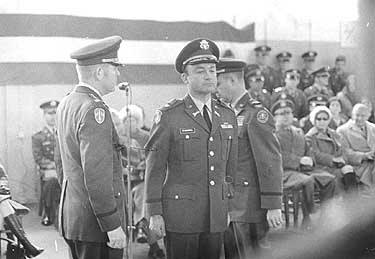 |
|
 |
|
|
|
Late November
1971, I assume command of the squadron in Bad
Kissingen. The ceremony was held in the gym; the
previous SCO, LTC Tuggle had already departed so the
photo shows at left, the SXO, LTC O'Connell, center,
and COL Graham, RCO of the 2nd ACR at right.
|
|
At the
ceremony, we had invited guests and family members
in the stands and commanders, staff and senior NCOs
of the squadron. |
|
| |
 |
|
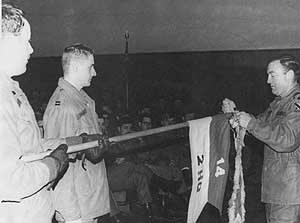 |
|
|
|
We were
attached to the 2nd ACR and actually designated as
the 4th Squadron. From left: 1st Squadron SCO, 2nd
Squadron SCO, LTC Tommy Smith, 2 ACR RCO, Col
Charles P. Graham, 3rd Squadron SCO and on far
right, LTC M.G. O'Connell, 4th Squadron SCO. Colonel
Graham retired at the grade of Lieutenant General. |
|
The men of HHT
receive an Honor Streamer. |
|
|
|
|
|
|
|
I went to the Regimental commander with a series of changes
I wanted to make and he gave me free reign. It was important
that the cavalry troop realize that the border mission was
very important and not get complacent but also, that all the
other training and maintenance missions get done as well. I
wanted that troop commander at a border camp and all the
soldiers out of Daley. During those first months, I was very
active on the border, checking the camps and calling out the
Reaction Force for command inspection. If I wasn't up there,
the S2 or Border NCO was.
| |
|
|
| |
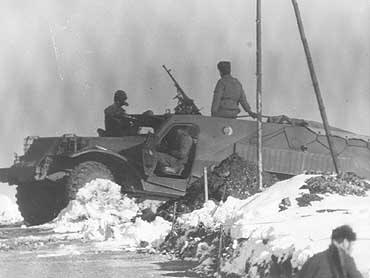 |
|
 |
|
|
|
They were
always at it; DDR guards with a personnel carrier by
a construction site.
|
|
This was part
of fixing up the second generation fence. I don't
recall they had that single fence program going on
yet. |
|
|
|
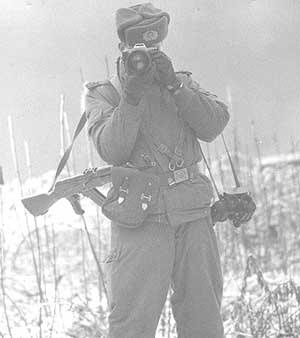 |
|
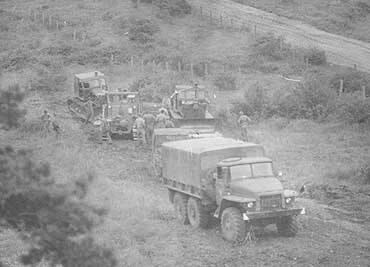 |
|
|
|
Here is a good
photo of a GAK. I don't think we called them that,
however. I think we just called them all "guards". |
|
The usual
construction program. |
|
|
|
|
|
|
Insofar as the camps, I was able to get
some small funds to continue the improvements to the
buildings. Soldier morale and quality of life were important
keys to what I wanted the border mission to be.
Once we re-flagged to the Blackhorse, the
mission became somewhat easier in that we now only had one
camp, Wollbach, and the length of the border to be observed
was reduced. Camp Wollbach may have been a little tight for
a cav troop but at least now, the entire chain of command
could monitor the situation from one location. I felt we
made steady progress in both our professionalism on the
border as well as getting everything else done.
| |
|
|
| |
 |
|
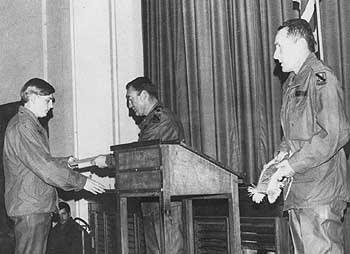 |
|
|
|
More of the
same. |
|
Each month we
tried to have a command briefing at the Post Theater
to keep all the troopers informed as well as
recognize those who had performed in an outstanding
fashion. I am at center handing out an award, CSM
Daley is at right.
|
|
| |
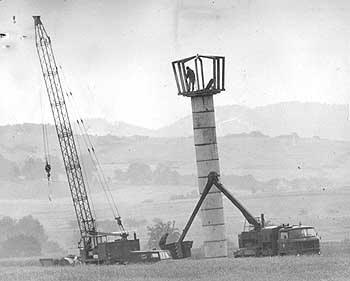 |
|
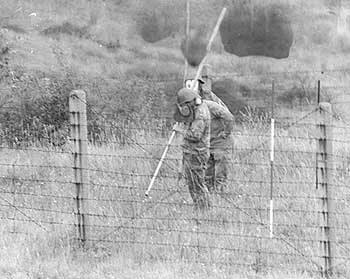 |
|
|
|
This was
interesting to watch, the building of a new tower. I
do not recall any of the wooden ones when I took
command but maybe there were a few. |
|
I guess you have to give
them credit for bravery or something to do that job |
|
| |
|
|
|
|
The re-flag did present a number of
challenges to the staff as all the reports changed when we
came back to the Blackhorse and there honestly was a
different approach to virtually all things in V Corps. We
spent many hours in meetings at Fulda to learn the new
"language" and get the changes out to the soldiers in an
understandable fashion. The staff did great work here.
I guess my best border story goes back to
the first months after taking command. We went out on alert
and then I had some freedom of maneuver. I ran that squadron
fast towards the border and we went into hide positions near
our defensive positions for several hours. After getting
back to BK, I received a call from the 2nd ACR commander. He
said he hoped we had enjoyed a good training experience and
.... that if I did that again, he wanted plenty of advanced
warning to himself and the regimental staff. A few days
later, I learned that our little maneuver had caused much
interest in East Germany and that several long silent radio
nets had suddenly sparked to life. The signal guys had a
field day listening in!"
| |
Click on thumbnail
to bring up the full-sized picture |
|
|
|
| |
 |
|
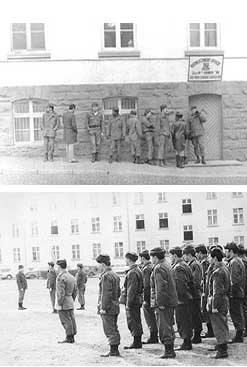 |
|
|
|
Here is a copy
of an East German Border Company Spot Report Summery
that Erwin Ritter found in the German Federal
Archives. It details how "two American soldiers
armed with pistols were captured just southwest of
Brix and then later turned over to the State
Ministry for Security." This would have been just
outside of the Eaglehorse sector. BG (Ret) O'Connell
noted, " I have no idea what those guys were talking
about because this did not happen. It would have
been the biggest story in Germany that year, I was
there and never heard of it!" Any help on this
mystery??
--Erwin Ritter |
|
This was a difficult
period for the Army. We still had draftees and
soldiers returning from Vietnam with only six months
of active duty remaining. There were drugs, racial
tensions and discipline problems. I had a strong
chain of command and little by little, we fought
each battle. Having the border mission helped, all
soldiers could see the reason for being in Germany. |
|
| |
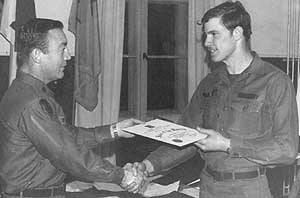 |
|
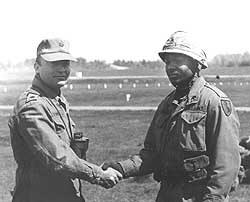 |
|
| |
Soldier
of the Month award to one of the troopers of the
squadron who helped make it all work. |
|
Another strong
soldier is recognized. Six months into the command,
I felt things had really improved: discipline, hard
training, positive feedback for doing good, a very
simple approach. |
|
| |
|
|
|
|
MSG (Ret) Scott Ford:
"I was the Eaglehorse Border NCO from
72-74 and spent a lot of time on the border, mostly after
the re-flag. I don't recall that I was involved with a lot
of border training for the troops. This was left up to the
troop commanders and maybe the S2. I don't recall having a
border knowledge test either. Things like the air insertions
and joint patrols with the Germans sound great but we did
not have either of those. The SBOC was under the control of
the S2, the GSR guys were in HHT and we controlled them.
They spent a lot of time at the border camp augmenting the
troop with the mission. I don't recall any other units
sending guys to help us out on the border except when we
went to gunnery, then the entire mission was handed off.
Usually I stayed behind to make sure this went OK.
| |
|
|
| |
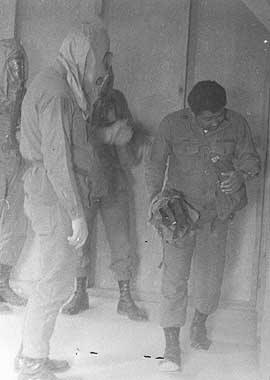 |
|
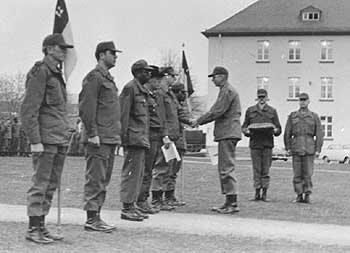 |
|
|
|
NBC training at
HTA. |
|
Blackhorse
commander, Colonel Clark, presents awards to select
squadron personnel. Note that we still wear the
baseball cap. The black berets came on board in
March or April of 73. |
|
|
|
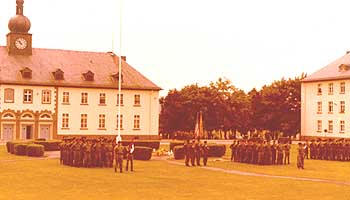 |
|
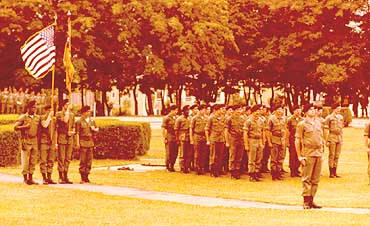 |
|
|
|
Squadron
formation as I turn command over to LTC Zeltman in
July 1973. We had come a long way and I was very
proud of the squadron that LTC Zeltman would
command. |
|
Detail of the
Eaglehorse formation at the change of command. |
|
| |
|
|
|
|
The patrolling of the border went on as usual, the fixed OP
by Highway 19 and then the jeep patrols moving along a
series of check points and calling in spot reports. I think
we had some track patrols but they were not a big part of
the program. We did not use How Battery on the border but
maybe they sent a few guys up at some point to help drive.
H Company was another matter. They were required more often
to help out and the talk was always on going about adding
them to the regular rotation. I think that by 1974, when
LTC Zeltman was the squadron commander, this may have
happened.
|
|
| |
 |
|
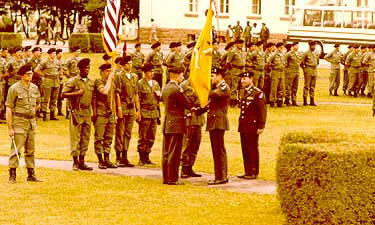 |
|
|
|
From left, RCO
Colonel Schweitzer, LTC O'Connell and LTC Zeltman. |
|
I would later
command a brigade in the US and then return to
Germany as the 8th ID Assistant Division Commander
(maneuver). I recall the command of the cavalry
squadron in Bad Kissingen as a major highlight in my
career. The successes we had came as a direct result
of the hard work of the troopers. |
|
Much of my time was spent on the border,
observing the East Germans and checking things out at Camp
Wollbach. We would call the Reaction Force out for
inspection and then there were "mini-alerts" just to test
the camp readiness. There may have been some IBC's but I
don't recall much about them. The rule was to hand anyone
like that off to the German police as soon as possible. I
don’t recall if we had a Camp Custodian or if it was all
handled by HHT Supply."
Big thanks to BG (Ret) O’Connell and MSG
(Ret) Ford for helping us get this part of the story
underway. If any other troopers would like to give us a hand
with their recollections of this period, please contact the
webmaster.
|
|
| |
The
Border Mission in Brief: 1978 - 1981 |
|
| |
Return to Top
Each company, troop and
battery in turn did a thirty day rotation at the border
camp performing the surveillance mission. This was
planned on the master training schedule; for level one
gunnery and participation in major FTX's and ARTEP's
which required participation of the three cavalry
troops and tank company, HOW battery was slotted to the
mission. Other alternatives in staffing allowed for
just scouts at the camp if a tank only training event
was occurring. On rare occasions, the entire mission
was handed off for a month to a designated divisional
cavalry troop from a V Corps unit.
Once at the camp, soldiers
were restricted to the area and civilian clothes were
not allowed. The only POV's allowed belonged to the
Troop Commander and perhaps one or two platoon leaders
/ platoon sergeants. Some First Sergeants went to the
camp, others remained with the supply section at Daley.
To accommodate soldiers processing in and out of the
unit, the troop kept its barracks open. A supply run
in the afternoon shuttled between Daley Barracks and the
camp carrying soldiers and supplies back and forth.
Usually a trooper could expect one or two 24 hour
periods off from the mission which could be spent back
in Bad Kissingen.
|
|
|
|
|
|
|
|
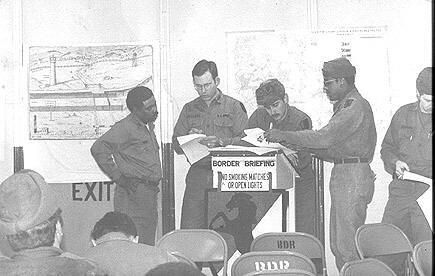
This photo, from
1980, shows personnel from How Battery in the
briefing area. At the lectern, center left, Lt
Cozzens, at right, Lt Cheatham. --Ted Cheatham |
|
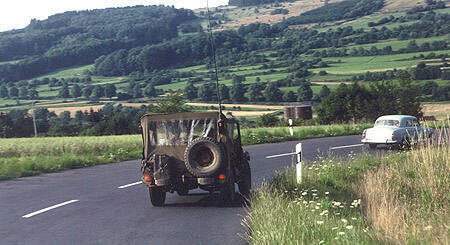
Seen in photo, an H
Company jeep, 1978, pressed into service,
speeds north towards Fladungen as part of a US
Patrol. As of 1979, all canvas was removed
from border mission jeeps.
--Stefanowicz |
|
|
|
|
|
|
|
The unit at the border camp
performed both the observation mission and a normal
training day to include vehicle maintenance. Depending
on the unit and creativity of the commander, border
rotations offered a wonderful opportunity to conduct
training away from Daley Barracks. Border operations
were supervised by the Border Camp OIC, usually a
"border qualified" lieutenant. Qualification was
basically an ad hoc term; the officer must have had at
least one prior border tour and be thoroughly familiar
with all aspects of the mission to the satisfaction of
the unit commander.
For those directly involved
with the border mission, this was a 24 hour day. Those
not involved in the mission were free, at the end of the
duty day, 1700 or so, to enjoy the advantages of camp
life. In the non winter months, the basketball court
and horse shoe pit were popular activities. The Day
Room offered a video tape player, although tapes were in
short supply in the early 1980's, a wide selection of
board games, magazines and books. The camp Beer Hall
opened at 1900 under the supervision of the platoon
sergeants. German bottled beer and soft drinks were
sold at a low price; there were snacks and hot dogs.
People in the current day border mission could not drink
beer, soldiers scheduled for the next day border mission
were cut off at 2000 hrs. The major activities at the
Beer Hall were card games and then the movie. 16 mm
movies, fresh from the AAFES system, were shown
nightly. The movies were handed from unit to unit
along the border trace every third day or so ... we
received our movies from the 3-7 Cav and handed them off
to the 1/11th ACR in the north. The hall was closed by
2200 hrs, I never saw the platoon sergeants lose control
of the situation. For those not interested in the Beer
Hall, some of the NCO's conducted marathon card and
dice tournaments in the barracks.
|
|
|
|
|
|
|
|
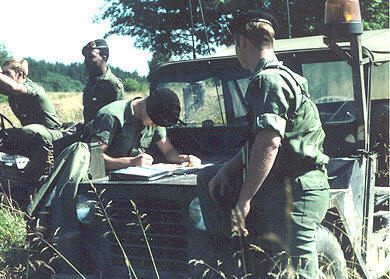
US Patrol , H
Company, 1978; from left, SP4 Finney, PFC Hill,
SGT Price, SGT McCellan. SGT Price writes a
spot report while Finney continues to observe.
The patrol drew live ammunition, five rounds per
man, issued by the camp armorer and accounted
for by stamped lot number. Additionally each
vehicle carried a metal "fuse case", a steel
box, banded shut containing additional
ammunition and flares. Much of what was
observed consisted of " day to day " activities
on the border. The intelligence value was
in determining if what was observed fell within
the expected norms or ... was a change from the
pattern. Either way, we reported what we
saw. The berets were gone by the start of
1979, uniform for all aspects of the border
mission became standard field set to include
helmet. Stefanowicz
|
|
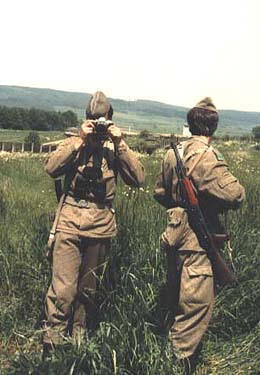
"They
took my picture ... now where did they put
it?!" Tom Sommerkamp on US Patrol, snaps the
photo just as a GAK does the same in 1980. The
GAKs took thousands of photos of US and West
German personnel on the border and Erwin Ritter
has been able to recover a few photos taken of
him but never could locate the files which must
contain thousands of photos of cavalry
troopers. The photos are probably located
somewhere in the archives containing the records
of the Border Troops and the STASI, the East
German secret police.
--Sommerkamp |
|
|
|
|
|
|
|
The duty day at
the border camp started early; the briefing for all
personnel involved with the current day mission
began at 0530. The briefing was given by the camp
OIC and covered in detail: the current day US wheel
patrol plan and areas of interest, areas of interest
for the fixed OP team, an overview of ongoing Border
Troop activities from recent days, a review of
standard patrol and reporting procedures, a review
of the rules covering Use of Deadly Force and
Reportable Border Incidents, a review of SMLM
sighting procedures and a review of West German
border patrol activities. In my experience, it took
about 45 minutes to go through the complete briefing
and answer any questions. All personnel then signed
a sheet indicating that they had heard and
understood the complete briefing.
The Eaglehorse squadron
patrolled 1/3 of its border trace each day with
the Wheeled US Patrol. A pair of jeeps, two
NCO's and four enlisted men followed the roads
and trails through a series of Patrol Vantage
Points, pre-designated check points along the
trace offering good views of the barrier
system. The patrol would pause at each PVP, and
send spot reports of any observed activity via
FM unsecured radio to the Border Operations
Center at Camp Wollbach / Lee. The patrol would
remain for 15 - 25 minutes at each point and
then continue on. In the event of unusual
activity, they might be directed to remain and
continue to observe the situation. Usually the
patrols were run during daylight hours.
|
|
|
|
|
|
|
|
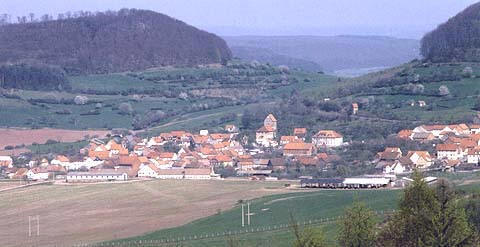
We observed the engineer
operations, GAKs, patrol and tower
activity of the East Germans. Sometimes
we observed the towns. Seen here,
Frankenheim, just past the Signal Fence,
a town of some size in the northern run
of the Eaglehorse sector. --Stefanowicz |
|
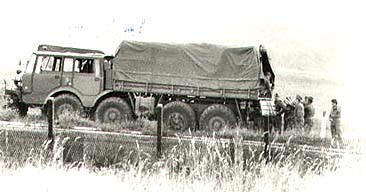
An engineer Tatra
813. US Patrol first began to observe
this type of vehicle on the border in
1980 and it could not immediately be
found in our recognition guides. We
simply referred to it as the "Bravo
Foxtrot Tango" ... "big f***ing truck".
--Ritter |
|
|
|
|
|
|
|
The border jeep fleet was a
constant source of problems. Three vehicles
devoted to the mission were in dire need of
constant maintenance as of 78 -79. If a border
jeep was not mission ready, the border unit
substituted one of its own to meet the
requirement. Often times, all three border
jeeps were not ready for operation despite being
matters of command concern. The fleet was
finally condemned as non repairable due to
massive uni-body rust and cracking and in 1979,
five new jeeps were issued. A border PLL was
authorized and established and a border wheel
vehicle mechanic position added to HHT and
staffed at the camp. These changes dramatically
improved the readiness and safety of the wheel
patrol program.
Dismounted
Patrols / Air Insertions / Track and
Tank Patrols in the Eaglehorse Border
Mission thru 1981
In addition to the US
Wheel Patrol, a number of other patrol
options existed for Eaglehorse troopers.
Normally, at least once each border tour,
the unit at Camp Wollbach / Lee would
conduct a dismounted patrol along a portion
of border sector. If the patrol could
cover the usual 1/3 rd of the trace,
it might be run in lieu of the wheel
patrol. Mostly , however, dismounted
operations were done in addition to the
standard patrol. Dismounted operations
followed all normal patrol procedures, at
least one border qualified E6 and a second
nco, four enlisted observers; radio contact
was maintained with a PRC - 77. Spot
reports and SITREPS flowed as required.
Radio communications could be a major
problem; the 77 had trouble reaching the
border camp and weather / terrain conditions
in the border area added problems. The
solution was to have the camp " stand - by
" jeep shadow the patrol but remain four or
five kilometers off the trace as a radio
relay. This jeep would also carry the "
fuse box " of additional ammunition. For a
new platoon leader on his first border tour,
dismounted patrolling was an ideal way to
learn the facts and lore of the border
mission from more experienced NCO 's and
enlisted men. Over the course of a four
week tour, some Lt's tried to coordinate
patrols to allow them to " walk the
entire trace ".
|
|
|
|
|
|
|
|
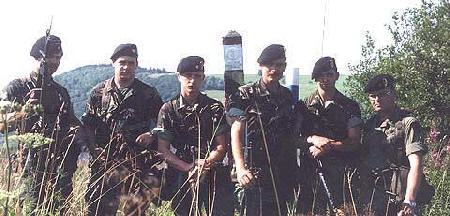
H Company dismounted patrol Summer
78; from left, PFC Finney, unknown,
Sp/4 Herbert, PVT McCall, SGT Price, SFC Sperry. --Stefanowicz |
|
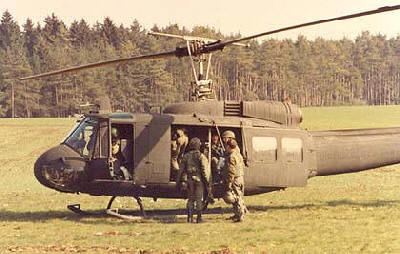
Troop G dismounted patrol air pick
up at Camp Lee, 1981. --Stefanowicz |
|
|
|
|
|
|
|
Once each border tour, regiment made a UH 1
available to conduct an air insertion of a
dismounted patrol into each squadron
sector. This event was coordinated on the
master schedule, pick up occurred at Camp
Lee and the patrol was inserted within a
kilometer of the border trace. For a 19D
scout or 19E tanker, this was an brief but
welcome change from normal procedures.
Tank and track patrols of
the border were conducted only in the winter
months and were a matter of coordination
between the Troop Commander and the SCO /
staff. The patrol ran as the standard US
patrol. Scout M113's had no difficulty
performing this mission although in the
event of mechanical problem, the camp had
to scramble personnel to continue the
required patrol. Tracked vehicles were
prohibited from closing beyond 50 meters of
the actual border. Tank patrols by H
Company were conducted in a similar fashion
... the tanks were escorted into the border
area then maneuvered on their own from PVP
to PVP. One tank would close to the 50
meter point while the second remained far
back in overwatch. The powerful optics
allowed for great observation of the east,
however, the Border Troops didn't
appreciate the turrets slewing back and
forth from tower to bunker to work party. I
believe the last tank patrol was conducted
in early 1979.
|
|
|
|
|
|
| |
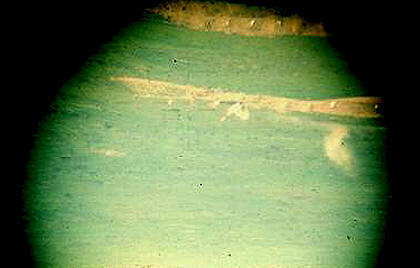
H
Company tank patrol on the border
1974; Ron Hudgins takes a photo
through the Primary Sight of the
Soviet Bee Hive Antenna Array.
--Hudgins |
|
|
|
|
|
|
|
These
activities were not designed to provoke the
Border Troops although, if they reacted, it
made for good spot reports. At the 7th Army
level, in Berlin, monthly meetings occurred
between representatives of West Germany, the
US Army and the East Germans to discuss and
resolve border related incidents and
complaints. Concerns over the "
provocative nature " of tanks on the border
probably led to this type of patrol being
prohibited as of mid 1979.
|
|
| |
Camouflage, Kevlar and the Smooth Rides: The Border Mission
and Camp Lee into the Mid 1980’s |
|
| |
A trooper who had departed in 1972 and then returned to the
Eaglehorse in mid 1981 would find some things changed but
much would still be very familiar. Cotton fatigues and the
berets were gone, "wash and wear" with baseball cap had been
the standard uniform for some time. The Sheridans were gone,
replaced by the well respected M60A3; the cavalry troop had
grown, more mortars, more 113s, more people, greater
capabilities. On the trace, Op 10 looking north toward
Meiningen was about the same, now known as OP Sierra. OP 13
by Breitensee was a burned out shell but still a known
landmark. The border camp had a new name and a new dining
facility; they had video tapes to watch in the Day Room but
little else had changed. Then things began to happen.
| |
|
|
|
|
| |
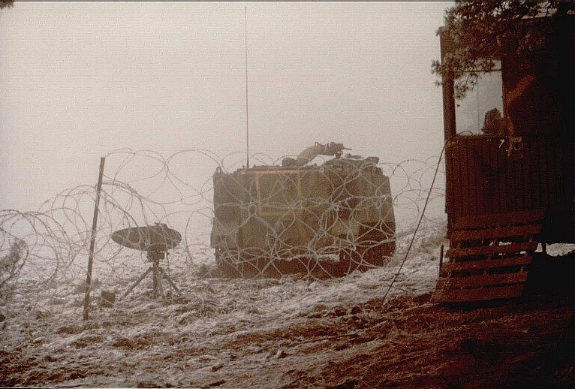
While the new OP
Tennessee was under construction, we moved down the
hill towards the border. Here is our temporary OP
one cold Winter day.
--Brian Reed |
|
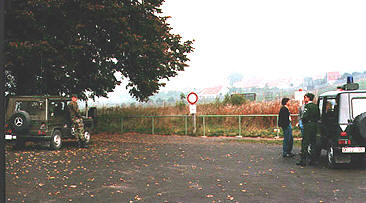
US Patrol and a BGS
patrol observe an East German town in the Eaglehorse
sector. Note the Mercedes "G" type vehicle on left.
These had taken the place of the M151's as used on
the border in the mid 1980's. Maintenance support
was partially passed off to TMP and repair parts
were locally sourced. They were 4 x 4 and offered a
" nice ride " but were not the robust combat vehicle
the Cav might have preferred.
--Favia / Ritter |
|
| |
|
|
|
|
Starting in the second half of 1981,
change was in the air in the Army and at Camp Lee. German
engineers were frequently seen at the border camp, on
escorted trips to OP Sierra and elsewhere on the trace. One
of the first noted improvements at Camp Lee came that summer
as "new" latrine / shower areas were added as "mini"
buildings attached to the ends of the existing barracks. The
old design, part of the pre fabricated buildings, simply
could not support the traffic of a cavalry troop and this
low cost solution was designed, funded and built to fix a
long standing problem. Later that year, the first camouflage
BDU uniforms began to show up in the duffel bags of new
troopers arriving from Fort Knox.
As each company, troop and battery in turn rotated through
Camp Lee the pace of change seemed to quicken. Long rumored
new OPs suddenly were becoming reality, the fielding plan
for the M1 tank was announced, border jeeps gave way to
Mercedes 4 x 4 SUVs, it was off to Hohenfels for Pony Fights
followed by Vielseck for the fielding of the M3. The beer
hall built by LTC Paul Palmer was gone in day, splinters and
sheet metal loaded into an open top container. Construction
started the following morning on the new Beer Hall. Ted
Prescott, Troop E Commander and Tom Favia, Border NCO a few
years later, help fill in the detail.
Ted Prescott:
"Here are some observations about Border Ops and Camp Lee
during my tenure 1983-1986."
"When I first arrived Border operations were still pretty
much conducted the way they had been done in the past. Units
rotated to the border every 30 days with all the normal
pain-in-the-ass inventories of ammunition and other items.
We still used the old reliable ¼ ton jeeps for patrols, but
I think all would agree they were on their last leg from all
the mileage and abuse heaped upon them. Sometime in the
1984-1985 we received new mounts. The old jeeps were
replaced with Mercedes 4x4 jeeps. These vehicles were a
godsend since they were closed in and the heater kicked ass
in the winter. For once you could cruise the Grenz in
comfort-at least when compared to the old jeeps. I don’t
know who was responsible for the change, but I would sure
like to buy them a beer. These vehicles were sturdy too. A
German rear-ended one in Bad Neustadt leaving only a scuff
mark on the bumper. The Audi didn’t fare as well. The entire
front end and hood was crumpled."
"On the Trace, the OPs were the new modular variety.
Sometime between 1980-1983 they had been constructed
replacing the shacks from the earlier years. The new
structures were heated, had running water (including toilet
facilities) and the living quarters were full of bunks for
the OP teams."
"During my stay there were some significant changes at Camp
Lee. I don’t know how long the changes had been in the
works, but I think SCOs LTC Bruce Clarke and LTC Tom Ramick
had their hands in it. One of the first changes was the
addition of the radio tower, which I believe was completed
during one of my E Troop rotations. I climbed to the top as
the commo guys were putting the finishing touches on the
wiring. Shortly afterward a commo specialist from HHT had
the unexpected honor to ride the old antenna mast down as it
collapsed onto the roof of the old BOC as they were
dismantling it. I think he broke his arm and was evaced back
to Bad Kissingen. Such were the hazards of border duty!"
| |
|
|
|
|
| |
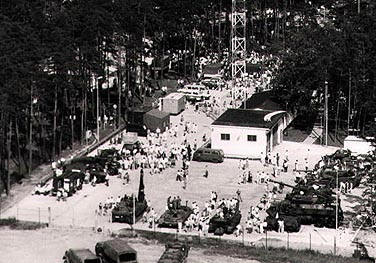
A well attended open
house at Camp Lee, 1988. Vehicle displays and
presentations by the BGS, Bavarian Border Police,
Bundeswehr and the Eaglehorse Squadron.
--Favia, Tom |
|
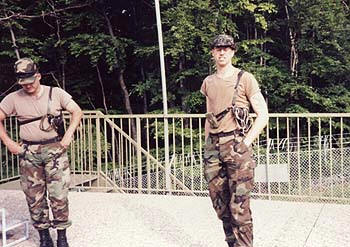
J Nichols and Hyder on
the observation deck of OP.
--Todd Stach |
|
| |
|
|
|
|
"Another change was the moving of the BOC. I believe it was
moved from the original structure by the gate to a newer
building by the Learning Center in 1984. The BOC was still
operating out of the new location when I left in December
1986, but I heard a new one was to be built on the site of
the original BOC."
"The BOC, though, wasn’t the only change. The barracks were
either renovated or replaced with newer modular buildings (I
can’t remember which), a new beer hall was constructed, the
motor pool was revamped, and a picnic area was added outside
the Mess Hall. It really spruced the place up."
"As for the patrols, we witnessed large-scale minefield
activity during 1984-1985 as the East Germans removed the
SM-501 fence mines and the land mines. Much to watch and
occasionally the engineers were injured or killed in the
process. Additionally, there was still some border and
signal fence construction in various areas."
"There were also a few successful escape attempts and I
believe the Bavarian Border Police snatched up a
real-to-life East German spy roaming the southern border
area in our sector. He was walking through the area when the
BBP stopped and quizzed him. He didn’t have the right
answers so he was arrested. He had infiltrated through the
border fence."
SFC (Ret) Tom Favia:
1. "The ( Mercedes ) G-Wagons were introduced as a TMP
vehicle. The logic was that they would be easily maintained
by TMP motor pools regarding scheduled maintenance and local
contracted Mercedes garages on the economy could do major
work. They were also intended to give a certain high profile
look to the patrols along the border. Unfortunately, these
models were not the best in terms of power and reliability
for such a mission. Therefore, they quickly proved
themselves as more of a POV (suv) than a system intended for
military operations. The introduction of the hmmwv (Kevlar
hard top version) was an immense improvement. It returned
the missions to a proper military posture. It proved
extremely reliable in any type of terrain and environment.
Naturally it created some logistical problems and challenges
in the beginning. We had to set up a small motor pool within
the operational border camps along with the necessary
personnel in order to support these new workhorses. However
the benefits of the hmmwv were enormous compared to its
disadvantages. The missions consisted of two vehicles, as
with the old Mercedes g-wagons, in order to accommodate a
squad size element."
| |
|
|
|
|
| |
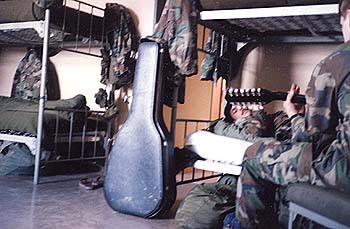
Interior view of the OP.
Todd Stach |
|
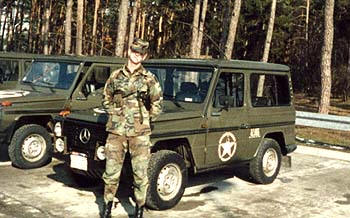
Todd Stach by the
Mercedes " G " type vehicles used for border
operations.
Todd Stach |
|
| |
|
|
|
|
2. "The border mission itself was not affected by the
introduction of new combat equipment into the regiment. The
M1s and M3s simply continued showing the combat presence at
the border camps and permanently manned OPs. There were,
however certain problems, due to the insistence of certain
troop commanders, in conducting combat patrols directly
along the border with these systems. It often raised a few
serious eyebrows from the East German border troops who
considered such matters as an incident along the border
(since gun tubes were always pointing across the border in
order to utilize their respective optics). However, after I
assumed duties as the Border Recon and Intel NCO drastic
changes were implemented in terms of the overall conduct of
mission. The Regimental Co and the Regimental Border Team
naturally blessed these changes. The patrols had become
simply a routine demonstration of U.S. military presence
along the IGB, but had long lost their effectiveness as a
serious reconnaissance patrol. The DDR Border forces new
precisely each checkpoint utilized by the U.S. patrols, and
once a few checkpoints had been visited they also could
easily determine the direction of travel. So, they could
adjust their presence and activities appropriately. I
ensured that the patrols became effective military recon
patrols. Placing the proper responsibility within the hands
of the patrol leaders easily did this. Check points were
eliminated and the border sector was divided into
operational sectors named after Primary Intelligence targets
across the geopolitical border. The Patrol schedule was
based on overlapping sector coverage over a specific period
of time. The patrol leader decided his movement within the
sectors utilizing military planning techniques and
implementing such into a five paragraph operations order
which he submitted first to the border team, and once
approved, was given to his patrol. This ensured that
movement in the sector was constantly varied based on
movement techniques, from north to south, and vice-versa.
The vehicles did not drive up and park at a checkpoint,
rather one vehicle remained in over watch some distance away
and concealed. The primary vehicle would also seek cover and
personnel would then dismount and tactically move towards a
vantage point in order to conduct reconnaissance of the
specified PRI and surrounding area. The entire regiment
under the order of Col Abrams then assumed this system,
which was first introduced into the Eaglehorse area of
operation."
| |
|
|
|
|
| |

SSG Favia, Eaglehorse
Border NCO, by the entrance to the new Camp Lee
Border Operations Center. |
|
| |
|
|
|
|
3. "The communications systems were all secure during my
tenure and later on I am certain the SINGARS replaced the
older secured radio systems. The landline to BK and Fulda
were still in place and was simply a daily commo check
requirement, which in fact was never used. We relied more
and more on the STU-III secure telecom system for more rapid
and extensive secure comms with the regimental border team."
4. "During my tenure the role of the Border Team changed
drastically. The Border Intelligence Officer was responsible
for the overall liaison between the Squadron Border
facilities and operations and the Squadron/Regimental HQ´s
respectively. He spent most of his time on the road between
BK and Fulda. When he was on the Camp he received full
detailed sitreps and updates from me, and we spent many
hours on the trace, day and night. My role was primarily
that of the reconnaissance and intelligence expert on the
border for our sector. I was basically on duty all year
round and day and night. I lived in a small village near the
camp, which gave me immediate access and mobility to the
border. As the Recon and Intel NCO I was also responsible
for all military operations on the camp/border and ops. This
included training of units/personnel to inspections and
operation center functions. As a German linguist I was also
the liaison NCO between our facility/operations and all
German agencies. The third member of the team was the
Director of Logistics. He dealt with all aspect of
logistical requirements from a thru z!"
|
|
| |
Eaglehorse Border Observation Posts 1972 - 1990 |
|
| |
Return to Top
The Eaglehorse Squadron, as
of 1972, maintained two fixed observation posts in the
border sector. The first one OP 10 known in my period
as OP Sierra and then re - built and re - named as OP
Tennessee in the mid 1980's, was located on a high spur
running east - west just behind the border near the
Eussenhausen Crossing Point. The OP offered great views
toward Meiningen and the bowl that funneled towards the
"Meiningen Gap". The crossing point and Highway 19 was
visible off to the lower right in the field of view, it
was not our primary focus although all traffic heading
towards the Border Troop control and inspection points
was visible. The OP lay approximately 200 meters behind
the border at the front and 100 meters away at the "
west " side where the border jogged in and around the
spur.
|
|
|
|
|
|
| |

Looking north along
the edge of the OP 1981, the matching unit and
antenna evident on the corner, GSR dish in
front. The woodline is in West Germany and this
was a matter of concern. As the trees grew,
more and more of the immediate area to the front
of the OP was obscured. Getting the trees
trimmed was a difficult proposition .... the
local Forest Manager (Waldmeister) didn't want
to do it ... the terrain was difficult and he
didn't want to cut the trees. I believe we
asked for the BGS and the Office of the Border
Resident, Corps level MI in sector, to assist.
Eventually, the forest manager cut off one
year's worth of growth. After I left, I imagine
they fought the same battle the following year.
--Sabas Peralta |
|
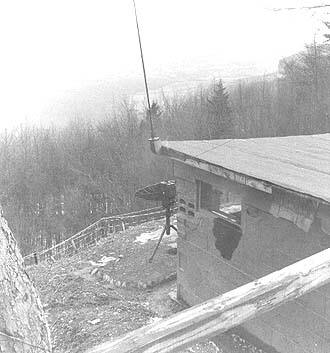
OP Sierra as of 1980. Looking
from the rear over the OP and towards Meiningen,
the observation portion is the left hand side,
the exhaust for the drip heater is visible, the
right hand side of the building was partially
screened off as a sleeping space. The OP had
unsecured FM voice and land line to the Border
Operations Center at Camp Lee. The " rough and
ready " aspect of the building is clearly
evident.
--Sommerkamp |
|
|
|
|
|
|
|
OP Sierra was staffed
continuously through the period of the border mission.
It had been built by the 2 /14 ACR, probably during the
construction phase at Camp Wollbach. The teams rotated
each 24 hrs from the border camp, shuttling back and
forth initially in a M113 and then M3 once issued.
The team consisted of two NCO's and four junior
enlisted. The NCO's were required to remain awake for
the entire tour of duty, the junior enlisted men
provided the gate guard at the OP, a daylight roving
guard at the barbed wire perimeter and assisted in
observing and reporting on East German activities. As
time allowed, the troopers were rotated in positions and
allowed to sleep in shifts. Often, the standard OP team
was augmented by a GSR team in a second M113. The radar
went into operation after sunset and allowed for " real
world " detection and tracking experience for the
operators.
|
|
|
|
|
|
| |
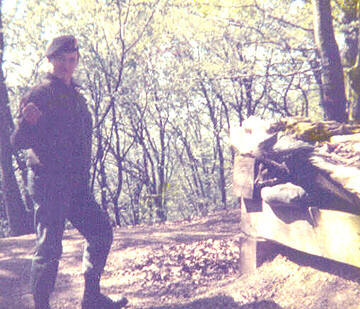
Railroad tie bunker by the gate
to the OP area, 1977. --Dan Thompson |
|
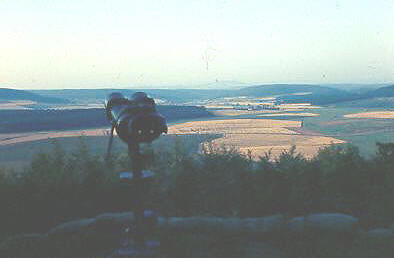
This image, from 1974, shows the
open expanse of the Meiningen Gap. We are
looking almost due North across the border from
OP 10; the city of Meiningen is visible in the
distance, Henneberg, a small village, is not
visible but would be to the right. The
Eussenhausen Crossing Point would be to the
extreme right. --Ron Hudgins |
|
|
|
|
|
|
|
OP Sierra initially had a
latrine with "catch and burn" system. This was replaced
by a commercial German "porta-pottie" and once or twice
each week, a "suck truck" negotiated the steep and
winding gravel trail to service the unit. This was a
matter of some humor to all concerned. The OP qualified
as a " remote site " and therefore was under scrutiny by
various Corps and USAREUR offices with little or no
interest in the actual border mission. As Border
Officer, I once escorted a USAREUR contact team to
inspect the "porta-pottie". They were the funding
control office for the invoices received from the German
latrine contractor and they wanted to insure that all
aspects of the contract were being met. I expected to
show them the OP and East Germany; they took little
interest in this as they thoroughly checked the
porta-pottie and reviewed in great detail the contract
and "suck" schedule with the contractor. Once
satisfied with the operation, they informed me they were
leaving and I led them out of the 1 K zone. I imagine
they had other latrines to check that day ...
|
|
|
|
|
|
|
|
ar |
|

Looking
from the former East Germany toward the spur
where OP Sierra / Tennessee one stood, 2000.
The OP would have been found in a clearing near
the top edge of the spur about half way from
right to left. With the exception of the
telephone poles that ran along the gravel trail
to the OP, all evidence of the US presence is
gone. --Bob Mathis
|
|
|
|
|
|
|
|
| |
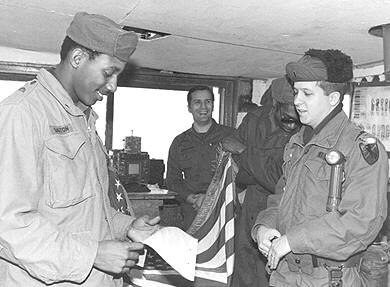
Lt Mitchell of G Troop has just
conducted a reenlistment at the OP for one of
his troopers. The photo gives a good view of
the interior of the OP and, seen on the counter,
center of frame, the GSR monitor. --Randy
Mitchell |
|
| |
|
|
|
|
OP 12 was the second fixed
site in our sector, it was similar in design to OP
Sierra and was located to the southeast, in the rolling
farmland near Sondheim. This was used only on occasion
and lost it's roof in early 1978 due to a fire started
by careless activity by a non-squadron GSR crew. The
site was still used but no efforts were made to repair
the damage. After this, non Eaglehorse GRS augmentation
teams were not allowed into the border area
without unless under direct control of a standard 2/11
OP team.
|
|
| |
Camp Harris-Hindenburg Kaserne: From Constabulary to the
Coburg Cubs |
|
| |
Return to Top
In the cavalry, it always helps to know who is on your
flanks. For US troopers stationed in Bad Kissingen, to the
northwest, the next sector was the responsibility of 1/14
ACR-1 /11 ACR depending on your time frame. This squadron
was stationed at Downs Barracks in Fulda and their border
observation mission was centered at OP Alpha. To the
southeast, as the Eaglehorse sector ended, the border was
patrolled by American forces operating out of Camp
Harris-Hindenburg Kaserne at Coburg. A wide array of units
passed through this barracks to include troopers from the
14th ACR, 2nd ACR, 3 ACR and 3rd Infantry Division. It is an
interesting chapter in the story of the American cavalry on
the border and the threads of history that pass through
Coburg extend to the Americans at Bad Kissingen and the 2
Kradschutzen Bn of the Third Reich era.
| |
|
|
| |
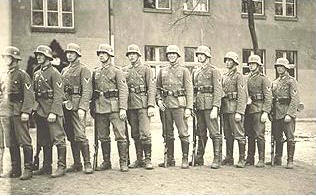 |
|
| |
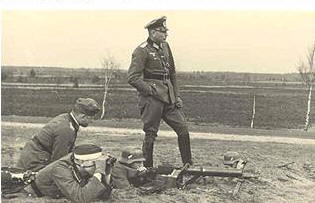 |
|
| |
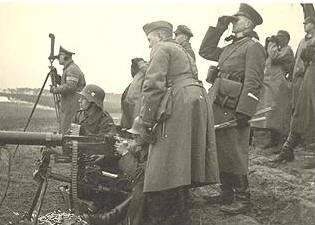 |
|
| |
Although not from
Coburg, three images of the German army training
in the mid 1930s. Top, infantry squad, middle,
training with the 08 Maxim machinegun, bottom,
machinegun complete with water jacket in the
assault. Scenes like this would have been very
typical for the 6 MG Bn at Hindenburg Kaserne in
1935.
--Stefanowicz |
|
| |
|
|
Coburg and Hindenburg Kaserne
Coburg is a small city located approximated 65 kilometers
east-northeast from Bad Kissingen and it is one of the
affordable, hidden jewels of central Germany. The old town
part of the city has most of the charm of Bad Kissingen
although it is not a Kur Stadt has no casino. Above the
town, on a towering hill, is a spectacular castle. Coburg
offers great shopping for china, Hummel figurines and world
famous stuffed toy animals for children. The wives of many
US servicemen may recall Coburg more than their husbands,
day trip bus tours to the china and toy factories were a
staple of Rec Service operations at dozens of US bases in
central Germany. Indicative of just how much has changed in
Germany, Coburg is now home to major festivals celebrating
New Orleans jazz and Brazilian Samba!
| |
|
|
|
|
| |
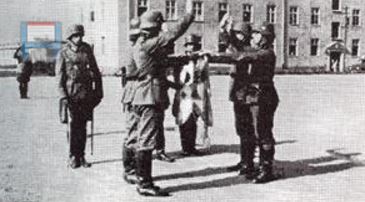
German soldiers swear
their oath of allegiance to the German people and
the Army at Hindenburg Kaserne, Coburg. Active units
had the training responsibility to integrate each
new wave of soldiers as they were called up in the
pre war years.
--Hans-Jürgen Schmidt
|
|

Post card image of
Hindenburg Kaserne from the pre war years. Very
similar to Manteuffel, it was a rectangle with a
total of six barracks along the long sides and mess
halls and administration buildings at the ends with
parade field in the middle. Motor shops were behind
the barracks buildings. Surrounding card is a
graphic detailing the composition of the 6 MG Bn: 1
- combat company with 3 MG platoons and one
motorcycle platoon, 2 - HQ +staff, como plt, support
troops, 3 - technical building and NCO barracks, 4 -
heavy company with engineer platoon, cannon platoon,
AT platoon and mortar section, 5 - technical
building, mess, EM club, NCO barracks.
--Hans-Jürgen Schmidt
|
|
| |
|
|
|
|
| |

Men of the 6 MG Bn
returning from the Anschluss of Austria.
--Hans-Jürgen Schmidt
|
|
| |
|
|
|
|
Hindenberg Kaserne in the pre war and WWII years
Hindenburg Kaserne, located not too far north of the town,
shared a similar history and design with Manteuffel Kaserne.
Built in the early -mid 1930s, the major tenant unit was the
6th Machinegun Battalion. An experimental unit
configuration, fully motorized and containing the most
modern equipment available to the Reichswehr and then early
Third Reich Heer, it appears to have been a combination
reconnaissance and shock attack unit. For a brief period, as
the 2 Krad Battalion moved from Eisenach to Bad Kissingen in
1937, it shared the Kaserne with the 6th MG Bn.
Once the war started, 6 MG Bn participated in the
fighting against Poland, France and the Low Countries and
both the unit and individual soldiers were highly decorated.
As was the normal pattern, the Coburg barracks became the
home to the training center for replacements designated for
that unit. In 1941, the battalion returned from France to
Wildflecken, was reconfigured and redesignated as the 40th
Kradschutzen battalion, part of the 10 Motorized Infantry
Division. With this, the unit training and replacement home
moved from Coburg to Regensburg and Hindenburg Kaserne
became home to a variety of Panzergrenadier replacement
training units. As with all the Kradschutzen battalions, in
1943, 40th Krad was reconfigured to an armored
reconnaissance battalion and spent the balance of the war
fighting in the East.
Coburg, Constabulary and the 6th Squadron
The United States Army had two major missions in immediate
post war Germany. The war against Japan with the anticipated
invasion of the home islands required that dozens of
divisions be quickly moved half way around the world to a
new theater of operations and, the basic law and order
structures of a society needed to be maintained in Germany
while the future shape of the county was considered. As
early as 1944, planning was well underway to determine how
to configure an American occupation force in Germany that
could be sufficiently flexible to assume a variety of non
wartime missions. Units needed to be fast, mobile and
motivated; they would be in almost constant contact with the
civilian population.
| |
|
|
|
|
| |

Command inspection of
the 6th Constabulary Squadron by MG Ernest Harmon,
Commander of Constabulary Operations, 1946.
--Ritter / USAREUR Historian |
|

Three troopers at
Coburg in typical Constabulary dress.
--Hans-Jürgen Schmidt |
|
| |
|
|
|
|
| |

In 1946, troopers of
the 6th Constabulary Squadron parade at Hindenburg
Kaserne for Major General Ernest H. Harmon, first
commander of Constabulary Forces.
--Hans-Jürgen Schmidt |
|
| |
|
|
|
|
In the American zone, by the Summer of 1946, with the
issue of Japan almost settled, the formal "Occupation Plan"
gave way to the "Zone Constabulary" with a tentative list of
primarily armored reconnaissance battalions as the major
participating units. A wide variety of missions were planned
for: control of smuggling, control of refugees, basic law
and order in assistance to the German police and vigorous
patrolling of both the roads and countryside as a show of
force to deter lawlessness. Constabulary units had their own
MTO & E, based on light equipment, no tanks and plenty of M8
"Greyhound" armored cars and jeeps. Among the many former
Wehrmacht barracks used to support Constabulary operations,
Hindenburg Kaserne, located close to the line separating the
American and Soviet zones in southern Germany, became the
home for the 6th Constabulary Squadron. In addition to all
other requirements, they also were responsible for
monitoring a legal crossing point into the Soviet zone at
Neustadt, northeast of Coburg.
The 6th Constabulary Squadron patrol area included the
Rhoen region that many years later would be the Maneuver
Rights Area and border area of the 2/14 ACR-2/11 ACR.
Running to the east, their operational area also contained a
large block of terrain towards Czechoslovakia.
Interestingly, Bad Kissingen never was a major Constabulary
post. Apparently, one Troop was located at Manteuffel
Kaserne until the entire barracks was vacated to make way
for the World Refugee Organization. The northern region of
the future Eaglehorse area was patrolled by Constabulary
personnel from Hammelberg, Schweinfurt and Fulda. The German
Zoll police, the first reconstituted national German law
enforcement organization, kept physical watch on the border
between the American and Soviet zone; the Constabulary
troopers assisted and monitored all other civil-police
aspects of society. The Americans had arrived, the
Constabulary period went better than anyone expected.
| |
|
|
|
|
| |
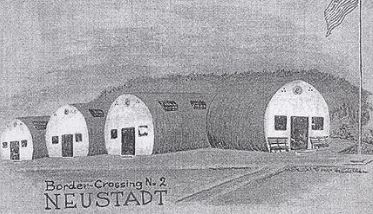
Neustadt crossing
point in the 6th Constabulary sector.
--Ritter / USAREUR Historian
|
|
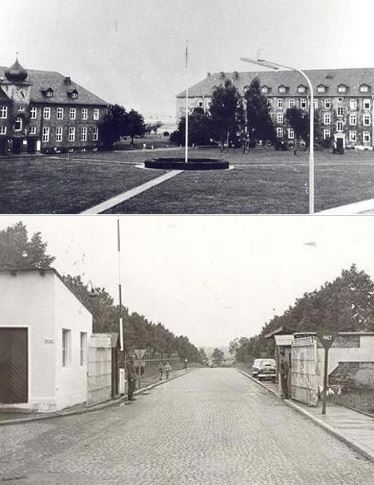
At top, interior view of the barracks area and at
bottom, the back gate.
--Hans-Jürgen Schmidt |
|
| |
|
|
|
|
| |

In 1949, following major exercises and
reconfiguration to a full combat unit, the 3rd
battalion, 14th ACR returns to Harris Barracks.
--Ritter / USAREUR Historian |
|
| |
|
|
|
|
Get the tanks!
As the Cold War began in the late 1940s, the lightly armed
Constabulary forces were seen as no match for any possible
Soviet attack. These units had been through several
different reorganizations and the logical step was to
initially rebuild combat units from select Constabulary
forces. The 14th Constabulary Regiment was redesignated as
the 14th Armored Cavalry Regiment and directed to
reconfigure under a combat unit MTO & E on 7 October 1948.
The 10th Constabulary Squadron in Fritzlar was redesignated
as the 1st Squadron, 14th Cavalry, the 1st Constabulary
Squadron was moved to Schweinfurt and redesignated as the
2nd Squadron and in Coburg, the 6th Constabulary Squadron
was redesignated as the 3rd Squadron, 14th Cavalry.
While still under the Constabulary command structure, the
14th Cavalry drew M24 and M26-46 tanks, ½ tracks and all the
other equipment authorized to a combat unit. They embarked
on a vigorous training program to insure proficiency with
both equipment and tactics and otherwise were relieved of
normal Constabulary police and civil functions. LTC Charles
A. Corcoran, in command of the now designated 3rd
Reconnaissance Battalion, 14th ACR, road marched through
gates at Hindenburg for seven straight weeks in the field
and on the ranges. Upon return, there was a major rotation
of personnel to the US and Major Van Duyn assumed command.
| |
|
|
|
|
| |
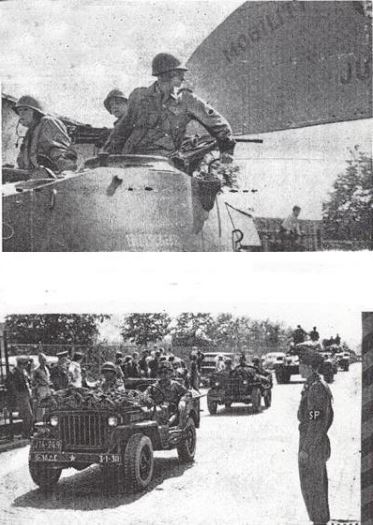
Tankers and scouts, happy to be finally home.
--Ritter / USAREUR Historian |
|
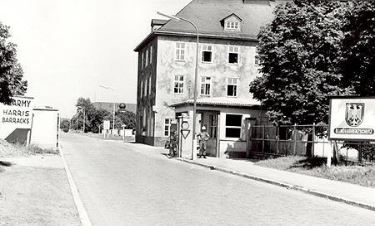
Main gate to Harris Barracks / Hindenburg Kaserne
featuring dual signs once the BGS established their
operations.
--Hans-Jürgen Schmidt
|
|
| |
|
|
|
|
| |
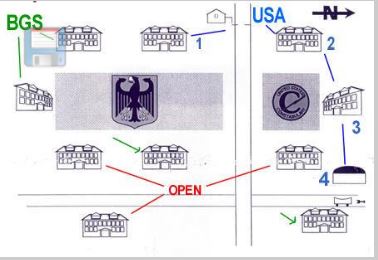
After the 3 - 14 departs in the final days of the
Constabulary period, a representation of the site
plan at Harris / Hindenburg, the US troops use #1 as
the mess, #2 as a company + size barracks and HQ, #3
as PX and #4 as the gym.
--Hans-Jürgen Schmidt |
|
| |
|
|
|
|
Welcome to Camp Harris
On 2 June, 1949, Hindenburg Kaserne was designated as Harris
Barracks to honor the actions of 2 Lt James R. Harris, 756th
Tank Battalion, who, had posthumously had been awarded the
Medal of Honor for actions in combat at Vagney, France,
1944. In summery, his award recalled that after a German
raiding party of tanks and infantry had infiltrated US lines
and attacked the battalion CP, Harris personally led a
counter attack with one tank and a squad of soldiers to
engage the superior enemy force. Fighting dismounted, Harris
directed the fire of his tank until it was destroyed and
continued to lead the squad despite severe wounds. After the
sharp fight the German force withdrew and Harris died of
wounds prior to evacuation.
The following year, the 3 -14 moved to Fritzlar and in 1952,
to Bad Hersfeld. In Coburg, the first of many different US
Army units arrived to call Camp Harris home.
| |
|
|
|
|
| |

From the Gray Bell collection,
service at Camp Harris with the 2/14 ACR sometime in
1970. |
|
| |
|
|
|
|
The 3rd ACR assumed the border mission along the long
southern portion of border running from Germany to
Czechoslovakia and ending at the Austrian border for much of
the 1950s. Also during this period, the Blackhorse Regiment,
deployed to Germany as a Gyroscope unit, had their first
experiences on the border to the far southeast. Troop sized
units from 3 ACR were rotated from Bamberg to Coburg during
this period and in 1958, the 2nd ACR assumed the mission. 3
ACR returned to the United States. For the next thirty
years, a wide variety of VII Corps company sized units
passed through the gates and border mission at Camp Harris.
Willkommen BGS ...
The West German internal security agency tasked with border
security, the Bundesgrenzschutz, BGS, was formally
authorized and funded for staffing in 1951 and early on
located units at Hindenburg Kaserne. For much of the Cold
War, they occupied 2/3rds of the available space at the
barracks. The Americans recall it as an amicable
relationship. By 1987, for example, Hindenburg Kaserne was
home to both BGS Southern Command "South 1" training unit
and the active border surveillance "Guard Battalion South
2". Erwin Ritter began his BGS career at Hindenburg Kaserne.
Along with the normal BGS observation functions along the
border, they also monitored the activities at the Neustadt
crossing point, although as with Eussenhaussen in the
Eaglehorse sector, the crossing point was primarily a Zoll
operation.
Into the 1960s ...
There are areas still unclear in the story of Camp Harris as
we reach the mid 1960s. The 2 ACR had assumed the border run
in southern Germany and Czechoslovakia and in 1966, the 2/14
ACR in Bad Kissingen was detached from the parent regiment
and formally attached to the 2 ACR. This brought the border
responsibilities in line with existing Corps boundaries in
the event of war. Of the troopers we have interviewed, they
fall into two distinct camps and it is odd how memories
vary.
Former officers and enlisted men alike recall Coburg and
Camp Harris as either a normal border responsibility for the
scouts from Daley or, as a camp they only used on occasion,
when the 2 ARC could not send a Troop due to major training
activities such as Level 1 gunnery. Either way, enough trips
to Coburg occurred to be recalled by several different
troopers from 1966-1972. In 1970, Terry Smith of Troop G,
2/14 ACR, recalls Camp Harris and border duty at Coburg.
Terry Smith:
"In my days it was called just Coburg or Camp Coburg and as
a general rule they split the Troop up with about half to
Wollbach and the other half to Coburg. Don't remember a lot
about Coburg other than I was surprised the first and only
time I was there because they had permanent billets just
like at Daley. I figured it would be like Wollbach but I do
remember a lot of guys telling me that I would really like
Coburg and they were right about that. That place was what
all border duty should have been like! It had permanent
barracks and was really very nice."
"While I was there, we occupied OP 20 and there were two
others 21 & 22. OP 20 was directly across the border from a
village with a communal barn if my memory serves me right.
One day on OP duty we were observing the fields around the
East German village and the farmers were chopping hay and
harvesting it. That struck me as being a little different
because were I'm from up in Minnesota, they chop the hay and
let it dry in the fields before they harvest it. I talked to
one of the guys I was pulling duty with, can't remember his
name, but I remember his face ... he was always STRAC
looking even after 24 hours on the border .... the rest of
us would look like we got dumped out of a duffel bag."
| |
|
|
|
|
| |
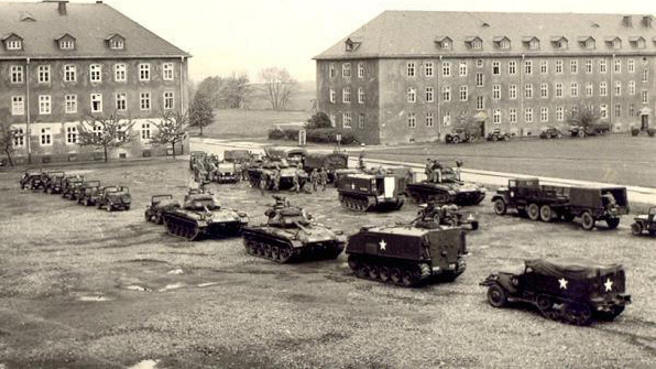
Nice view of an unknown cavalry
platoon as it moves into Camp Harris in the early
1950s. The left file features scout section jeeps,
then M41 tanks, M75 mortar carriers and finally the
infantry squad ½ track. Second file, more of the
same plus the support wheels.
--Hans-Jürgen Schmidt |
|
| |
|
|
|
|
| |
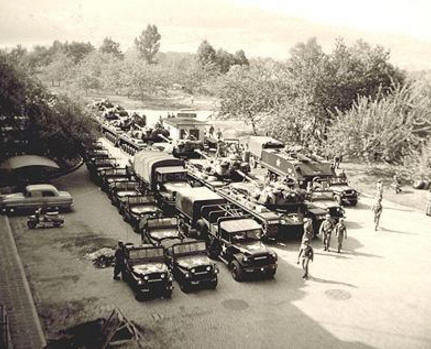
A few years later, the equipment has
changed as another unidentified scout unit, jeeps,
M58 APCs and M48 tanks visible, occupies Camp
Harris. This would probably be about 1960.
--Hans-Jürgen Schmidt |
|
| |
|
|
|
|
"I was b's ing with the guy about how the Germans on the
other side were harvesting the hay and hauling it to the
communal barn without letting it dry in the fields. He was
from NY City so he did not understand what I was talking
about and asked me to explain. I told him how green hay, if
it is wet and put up without being dried, was known to
spontaneously combust and that farmers where I was from just
didn't do that unless it was a really wet Summer. I asked
him if there had been a lot of rain while I was gone on
leave and they said "no", so I just racked it up as another
strange thing that the krauts do."
"Well ... about three hours later I was looking at the
communal barn and I thought I saw smoke, just a wisp and I
told the other guy and we both watched the barn. Within
15-20 minutes the whole damn barn was burning and this was
the biggest barn I had ever seen ... it had to be at least
400 feet long. When it became apparent that the krauts were
going to have a 20 alarm fire we started sending in a spot
reports and kept sending them in every time something
happened ... we reported each fire truck that arrived etc.
It was the most exciting time I'd ever had on the border!"
"Jesus did that barn burn. When everything ended and we were
relieved the next day, what had happened was the talk of the
Troop and I got all the credit for pointing out to one my
buddies that this had a high potential for happening. We
told and retold that adventure over a lot of beers."
BG (Ret) Mike O'Connell, SCO of the 2/14 ACR, recalled that
as part of the re-flag in 1972, he was happy to be rid of
the duel camp requirement. With a smaller sector, he wanted
the entire Troop committed to a single camp for the border
rotation and this led to a serious look at Camp Wollbach for
expansion.
The 14th ACR re-flagged to the 11th ACR in 1972 , the Second
Squadron returned to the Blackhorse the following year, only
after much discussion and negotiation between V Corps and
VII Corps. There were a number of issues at stake, the Corps
boundaries in the event of war and the ability of the 2 ACR
to stretch and observe a seemingly ever growing length of
border while still maintaining all aspects of combat
readiness were major talking points. A search began for new
units to be included in the observation mission to assist
the 2 ACR.
At Coburg, responsibilities ended for the troopers of the
Blackhorse. It appears that the Coburg sector became the
responsibility of 2nd Squadron, 2 ACR as one of two forward
border camps. Early on, the 3-7 Cavalry Squadron, divisional
cavalry of the 3rd Infantry Division located in Schweinfurt,
was tasked to support the mission. In the old divisional
structure with three ground Troops in the unit, it was a
burden but there was plenty of augmentation assistance
available from other battalions in Schwienfurt.
The otherwise excellent William E. Staley study of US border
Operations in Germany on line at the Center for Military
History,
http://www.army.mil/cmh-pg/documents/BorderOps/content.htm
does not address in any detail this period at Camp Harris.
It does state that the placement of the 3-7 Cav under 2 ACR
control for border operations did not officially occur unit
September 1977. Perhaps in the immediately previous years
there had been a less formal command structure.
Bob Suckman recalls border duty at Coburg with the 3-7 Cav
during the 1972-1974 period.
"A few weeks before we were to be deployed, we would start
hours of classroom training and review. We would learn
recognition of Warsaw Pact military equipment, such as
uniforms, personal weapons, vehicles, planes and
helicopters. We would learn how to complete the necessary
paperwork for our particular jobs: spot reports, weather
reports, vehicle status reports. We would learn how to use
the code books and properly decipher messages. We would also
go over proper radio procedure. We would learn how to read
maps, terrain features, grid coordinates."
"The vehicles that we were going to be taking with us, were
all thoroughly checked and given high priority for needed
parts to bring them up snuff, even appearance wise. If I
remember correctly, we would take jeeps, 1/4 ton trucks,
M113 APCs, M114 scout tanks, Sheridan tanks, tank
retrievers, 2 1/2 ton trucks. We also took an array of
weapons with us: 45 pistols, M16 rifles, M60 machine guns,
50 caliber machine guns, LAWS and I think grenade launchers.
Of course we took all the ammo that went with the weapons
and weapon systems."
"Coburg was the Taj Mahal of border camps. Big, white,
clean, and well maintained buildings. The grounds were well
kept, with nice lawns and shrubs. Compared to a camp I was
at on the Czech border, Coburg was a resort. Upon arrival at
Camp Harris, we would relieve the previous unit there, and
be briefed. Road patrols would consist of two jeeps with 6
to 8 troopers assigned. Each jeep would have a driver,
gunner and patrol leader/observer. Each jeep would have a
combat load of 45s, M16s, M60 machine guns, grenades and
ammunition."
"Everyday, a patrol would be sent out at different times of
the day. Patrols would last anywhere from 8-12 hours. There
were several different patrol routes that could be set up.
The patrol had specific check points that they had to go to
and they had to dismount and observe the border and report
back to base any activity, civilian or military, also
weather reports. They could get no closer than 10 meters to
the actual border. They had to stay at each check point a
specified amount of time. Arrival and departure times had to
be recorded. Upon return to camp, the patrols would turn in
their equipment and ammo, finish the paperwork and be
debriefed. We had 3 patrol units, so each patrol would have
a patrol day, a day off and a day for details, work on
vehicles and other such activities."
"Observation posts were manned 24/7, with a 24 hour shift
per team. If I remember right, each team consisted of around
8 people. I think 4 troopers were assigned as guards and 4
were assigned as observers. I'm not sure of the numbers, but
you get the idea. The guards were assigned to patrol the
road entrance to the OP and were armed with a M16 and a
telephone connected to the OP."
"The observers would watch the area to the front of the OP
and call in ' Spot Reports ' of any activity, civilian or
military, to the Operations Center back at Camp Harris. OPs
were usually located in a wooded area on top of a hill. The
area being observed usually was a well traveled road or area
of military activity. The OPs were set up with an area in
the front of the post for observation equipped with radios
and telephone, binoculars, scope, map and manuals. The back
area of the OP was for troopers to sleep when they were
off."
"Along with Spot Reports, the OP would send back weather
information. Spot Reports and Weather Reports were on a
standard form and were relayed back to Operations by line
number.
Hot meals were transported to the OP by support personnel
from the Troop. On occasion, a special team of soldiers
trained in the use of night vision scopes and listening
devices, would set up at night along side the OP and use
their equipment to observe the border. Remember, this was
back in 1971 and the Army wasn't equipped yet with all the
modern night vision devices as it is now. Upon being
relieved in the morning, by another team, the team would
turn in the paperwork and be debriefed. The OP was armed
with the same basic equipment as a road patrol. I think each
team had their own jeeps and kept them on sight in case they
had to leave in a hurry (not sure of this point)."
"The Border Operations Center at Camp Harris was manned 24/7
by an Operations Sergeant and an assistant/runner. The
center is where the patrols and Observation Posts call in
the spot reports to. The reports come in by line number for
ease of reporting and recording. The Op Sgt. checks accuracy
of coordinates and completeness of report and then calls in
the report to the next link in the chain, Nurnburg. The time
of receiving the report and sending the report back out are
recorded in the log book. The report needs to be sent back
out in a timely manner or the information is not worth
anything. Weather reports are also called in the same
manner. Contact must be maintained with the patrols and the
OP's. If nothing comes in from either, communication checks
had to be made at least once an hour and recorded."
"The operation center had 3 teams, 24 hours on and 48 hours
off. The center had phones to the OP's and Nurnburg and
radios to the OP's and patrols and to Nurnburg. Also in the
Operations Center, was a Crypto room and operator. No one
had admittance to this area but the operator. There was also
a room set up for debriefing of the patrols and OP's and
briefings of any visiting commanders. The Operations Sgt.
was also in charge of the code books and passwords making
sure they were secured."
"In case of an invasion, the Operations Center had to be
maintained to the very end, to continue sending in reports
from patrols and ops. If possible, a helicopter would be
sent to pull us out at the last possible moment (yeah
right). The Crypto operator had explosives to destroy the
center and all its contents. The Cav had an expected life
span of about 10 minutes under a full invasion. We were to
report what was coming, from where and to where. Real
comforting to know we were expendable but what we did would
give the rear areas time to repel an invasion and slow it
down. As I look back on it now, I liked the cav assignment
in Schweinfurt and I enjoyed the border, it really opened
your eyes."
The constant requirement for a unit at Camp Harris led to
new opportunities for VII Corps units. To relieve some of
the burden from the divisional cavalry squadron in
Schweinfurt, a heavy augmentation plan was developed which
gave soldiers who might otherwise have never seen the border
an opportunity to participate in the surveillance mission.
Erwin Ritter had a chance to visit the office of the USAREUR
Historian and go through files related to the US Army and
the border mission. He found an article from the First Armor
Division newspaper,"Ironsides", dated September 23, 1983
titled: "Blowout! Infantrymen react at a moment's notice"
From this article,
"The 1-6 Infantry soldiers spent 28 days at Camp Harris
guarding 160 kilometers of the East-West German border.
While many of them had pulled duty before on the Czech
border at Camp Pitman, this was something new for the
soldiers. ... ' When we were offered the mission of
augmenting the border, I jumped at the chance,' said Captain
Steve Herbert, Company Commander. ' It's a CO's dream ...
all the training you get up here-soldier combat skills,
terrain walks, learning the border itself, maintenance and
sustainment NCOPD classes and interfacing with the German
agencies.'".
The article continued with several photos to detail life at
Harris and the mission from the perspective of several
different soldiers. An extensive train-up period had first
been conducted to insure that all aspects of the border
mission were thoroughly understood by the entire unit. To a
man, the interviewed soldiers commented that it was a great
experience and certainly opened their eyes to the reality of
the East-West conflict.
Also appearing in the records of the USAREUR Historian was a
mid 80s summery report from the 3rd Infantry Division
reflecting the reorganization of subordinate units to
Division 86 configuration and the transition of the cavalry
squadron to the new MTO & E featuring only two ground Troops
and two air Troops. Specific paragraphs detailed the major
training events of the 3 -7 Cav to include winning the Flynn
Challenge Cup, a VII Corps competition testing border unit
readiness, knowledge and professionalism. A few years later,
Gary M. Tobin recalls the continued involvement of the 3-7
Cav on the border
Col (Ret) Gary M. Tobin:
"I commanded the 3-7 Cav in 1986-1988 and recall border
operations at Camp Harris. The squadron was in the Division
86 configuration so we had two ground Troops and two Air
Troops. The rotation had been greatly expanded to meet the
requirements and I certainly recall the infantry battalion
in Schweinfurt and perhaps the tank battalions as well
sending companies or teams to Camp Harris. But having said
this, there also were times my squadron assumed the entire
border mission of the 2 ACR. We would staff all of their
camps and perform the mission when they departed for gunnery
or major maneuver training."
"We had an excellent Border Officer living in Coburg and a
very good training program had been developed to insure that
as a company or team deployed to the border, they were fully
trained. As a unit went to Harris, it reported to the 2 ACR.
In our sector was a legal crossing point at Neustadt and
that was always interesting."
"I do not recall using any fixed OPs at the time, I believe
everything was done in the Humvees and of course, we had
plenty of air assets as well. My recollection is that it was
a smooth running operation but one day, a tour bus full of
American wives from somewhere in Germany took a wrong turn
and ended up in the 1 K zone. Our patrol came upon them and
escorted them to the camp. I guess we would have liked to
have found a way to just get them on the right path but ...
this was a serious incident in the SOP so we couldn't depart
from the rules. I'm sure it gave them all quite a story to
tell!"
"The border was something of a distraction to all the other
things we wanted to get done, but it did give the troopers a
chance to see something they otherwise would have missed and
it did build espit de' corps. If I had the choice to remove
the squadron from border responsibility, I never would have
done it. It was a great opportunity for the entire chain of
command."
The end of the border mission came in 1990 with elements of
the redesignated 3-4 Cavalry Squadron at Camp Harris. The
Hindenburg Kaserne area was returned to full German control
in April of that year. The BGS continued to maintain a
presence there for a while but in the mid 1990s, a
reorganization led to the closing of that facility. We
searched for on line articles in the German press related to
further developments and found that as expected, the closing
and attempts of local politicians to bring the BGS back had
been matters of great local concern.
A lengthy article detailed Coburg civil police conducting
major training exercises in a part of the Hindenburg Kaserne
complex and we noted, that along with Samba and jazz,
baseball has found a niche home in Coburg. One on line
notice called attention to the local Coburg baseball team
conducting Winter practices in the former BGS gym. I guess
the "three-six-three double play" would be translated as the
"drei-sechs-drei Doppelaus".
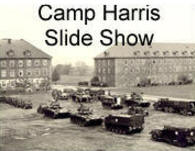
The Roman empire left coins and spear points
all over the world, the British empire spread English and
common law where it passed and the Americans, as empire
builders always the most bashful and willing to leave when
the job was done, left behind baseball.
The barracks area that was in constant use from the
Constabulary days to the end of the Cold War, basically
unchanged from the mid 1990s and certainly recognizable, now
waits for redevelopment. The baseball field is well
maintained. Play ball!!
|
|
| |
Eaglehorse Squadron Border Personnel and Activities |
|
| |
Return to Top
Reaction Force was staffed
with each new 24 hour border mission team. It consisted of
an E6 with at least a three man crew manning an M113. They
attended the morning briefing, drew ammunition and remained
in or near their M113 parked opposite the Border Operations
Center for the day. The border camp OIC would call this
force to alert and conduct an inspection once during the
day to insure readiness. The camp siren system signaled
the alert. In the event of loss of communication with a US
element on the border or any other border related
emergency, the Reaction Force was called out and prepared
to move. Communication related problems could normally be
fixed by the stand - by jeep deploying to high ground
between Camp Lee and the border to serve as a relay.
Regimental Border Operations, however, had its own border
readiness inspection program and would, on occasion, visit
OP Sierra and direct the team to not answer standard radio
checks. They would then time the period between the loss of
communication and the arrival of the Reaction Force.
Inspections of this type continued through at least 1979.
As new equipment was fielded to the Eaglehorse, the M113 was
replaced by an M3.
Stand-By jeep and driver were
used by the camp OIC to monitor and assist the border
observation mission. The driver attended the morning
briefing. OP Sierra was visited at least twice per day by
the OIC to inspect readiness and to feed the team. US
patrol also would be fed at least once and any other units
on the trace were checked. The jeep was also used to
establish observation along the border as the situation
demanded.
Border Operations Center at Camp Lee
provided quality control and oversight of the patrols and
OP's along the border. The center, staffed by an E6, E5 and
junior enlisted runner, maintained radio communication with
all border deployed troops. As spot reports came in by FM
or land line, they were placed in written format, reviewed
for completeness and passed via unsecure line to the
Squadron Border Operations Center at Daley Barracks. The
center also maintained an accurate situation map to monitor
"who / where / what" in the Eaglehorse sector and a
"time-event" log of all significant border activities. The
tour of duty was 24 hrs; the NCO's remained awake, the
runner could rest if not otherwise employed. Often, the
camp OIC would "sit in" at the Operation Center to maintain
full awareness of the border mission status.
Squadron Border Operations
Center Located in a secured space adjacent to the
S2 shop at Daley Barracks, the Squadron Border Operations
Center maintained radio and land line communication with the
Camp Lee operations center. The SBOC was staffed 24 /7 in
eight hour shifts by an E6 and E5. They received spot
reports and other information from Camp Lee, reviewed for
completeness and passed the reports to Regimental Border
Operations in Fulda expeditiously via land line. They
maintained logs, situational maps of the border area and
drafted daily and weekly consolidations of US patrolling
activities and spot reports. They maintained FM and AM
radio links to Fulda.
Border Camp Custodian: This position was
filled as necessary to provide NCO oversight to the
administrative aspects of the day to day operations of Camp
Lee. Usually filled by an E6 or E7, the custodian had
quarters at the camp but usually spent weekends in Bad
Kissingen. The custodian checked on the HHT medics and
wheel vehicle mechanic at the camp, identified and repaired
facility related problems and coordinated with Facility
Engineers at Daley Barracks for problems beyond his
capabilities. He assisted in the transfer of the camp from
unit to unit.
Squadron Border NCO: Usually an E6 or E7,
this NCO was a key player in the instruction, coordination
and quality control efforts of the Eaglehorse squadron
border mission. This was a demanding position requiring
complete knowledge of all aspects of the border mission. He
operated independently with a driver to teach, inspect and
assist the unit currently assigned to Camp Lee as well as
train select personnel of the next unit in rotation. He
interacted on a daily basis with squadron staff, the border
unit and West German border observation and policing
units. The Border NCO reported to the Squadron Border
Officer.
The Squadron Border Officer: was a special
staff position filled as necessary, reporting to the SXO on
all border camp and surveillance operational and
administrative issues. The position was normally filled by
a first lieutenant or captain. The Border Officer was
responsible for the activities of the Border NCO,
the custodian, staffing and operations of the SBOC. He
worked to coordinate with and assist units, squadron
staff, Regimental Border Operations and outside civil,
military and German agencies with an interest in the
Eaglehorse border surveillance mission, facilities and real
property.
| |
|
|
|
|
| |
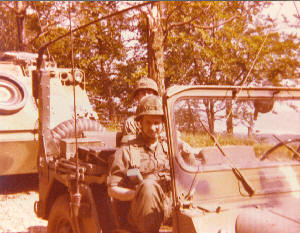
LT Mitchell in The
Stand-By jeep during one
of the twice daily inspections of OP Sierra,
Spring 1980 --Mitchell |
|
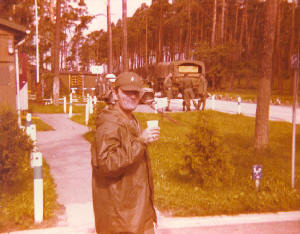
LT Bob
Stefanowicz, Squadron Border Officer,
Spring 1980 --Mitchell |
|
| |
|
|
|
|
| |
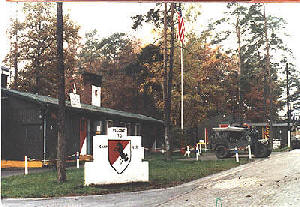
The Border Operations
Center, Camp Lee --Sommerkamp |
|

Eye witnesses
to history, December 1989. Eaglehorse Border Officer
and Border NCO, respectively CPT La Vulo, center,
and SG Roberts, with officers of the BGS near
Melpers in the northern run of the
Eaglehorse sector. Border Troop engineers cut the
first of many roads through the barrier system to
open the East German border. --Ritter |
|
| |
|
|
|
|
| |
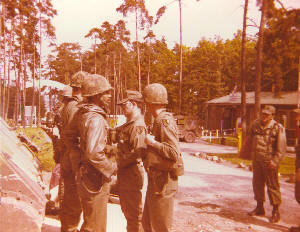
The G Troop
Reaction Force being inspected by the Troop
Commander, CPT Terry Campbell, Spring, 1980
--Mitchell |
|
| |
|
|
|
|
|
|
| |
The "New" Border
Observation Posts |
|
| |
Return to Top
Jack Tartella, Eaglehorse S2
in 77 - 78, relates the following about the " new "
border observation posts in sector: the plan was driven
by one of the chiefs of Facilities Engineering in
Schweinfurt. Daley Barracks was their responsibility
and they also had responsibility for the off barracks
sites. The guy couldn't believe that the Army used such
a " dump " as an OP and he had a plan to update things.
There were many problems, however, not the least of
which was, the Cav was a V Corps unit and the management
of real property in Schweinfurt / BK was a VII Corps
responsibility. There were also problems in land
acquisition and design of the "new" OP's.
As Border Officer, I saw
the squadron copy of the plan in 1979. It existed as a
file folder about 3/4 inch thick detailing all the
memos, plans and discussions. Twice I sat in at
meetings on this issue, in Schweinfurt and at the BGS
Barracks; attending were representatives of USAREUR,
Schweinfurt FE and Real Property, the BGS and others.
There were discussions covering highly detailed plans to
compensate German farmers for the loss of land involved
in the OP plan, how and when trash would be picked up,
control of land pollution from oil / diesel leaks, a
plan to compensate the farmer if " the US force fires a
flare ... and the expended flare falls into a pasture
.... and a cow eats this and dies .... who will pay and
how much ". Also under discussion was the design. The
BGS didn't want anything that resembled an East German
bunker / tower. Jack Tartella had warned me that " the
plan existed before he got to BK and would exist
after you leave ... " and he was absolutely correct.
When I left the job in 1980, although the file was a
little thicker, the plan seemed no closer
to execution . How wrong I was.
Four new border OP's were
built in 1984 - 85 in the Eaglehorse sector. They had a
unique design that did not resemble anything seen in the
DDR and clearly were a marked improvement. All four
buildings followed the same blueprint. From north to
south, OP 10 by Bruchs - Fladungen, OP Tennessee in
place of OP Sierra, OP 12 by Sondheim and OP 13 near
Breitensee. Of the four, Tennessee was staffed by US
forces 24 / 7; the other OP's were manned periodically.
The BGS also had keys to these buildings and conducted
their own observation program. When the border mission
ended, all traces of the OP's were removed.
| |
|
|
|
|
| |
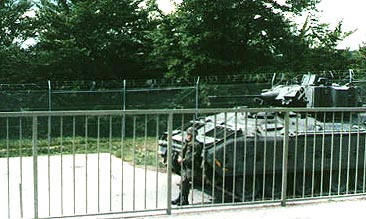
M3 by OP Tennessee hardstand,
1989.
--SSG
Favia |
|
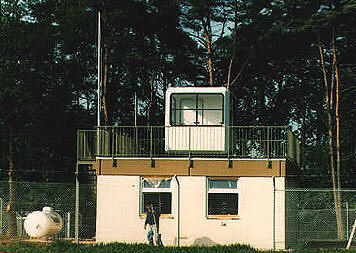
OP 12 by Sondheim as
seen from the edge of the border.
--Ritter |
|
| |
|
|
|
|
| |
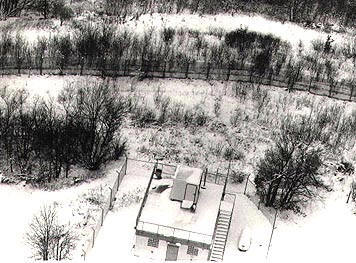
OP 10 as seen from
above; the barrier fence immediately to the
front.
--Ritter |
|
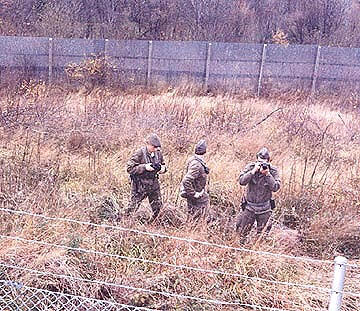
SSG Favia, Squadron Border NCO, snaps photo of
patrolling GAKs immediately in front of new OP 10 as
GAKs take his picture. --Favia |
|
| |
|
|
|
|
| |

OP 10 as photographed by a GAK, 1988.
--Ritter |
|
| |
|
|
|
|
| |
|
|
| |
Air Assets
Along the Eaglehorse Border |
|
| |
Return to Top
Detached from Air Troop, 4/11 ACR in Fulda, was one OH 58
scout helicopter, pilot, crew chief and mechanic. This
aircraft was maintained at the flight strip in the
Reiterswiesen training area, about five kilometers from
Daley Barracks. As weather and maintenance permitted, the
aircraft with an observer made daily flights of the
complete squadron sector. The observer varied, Border NCO,
Border Officer and S2 all had opportunities. Standard spot
report procedures were followed. The pilots took great pride
in their ability to follow the convoluted path of the border
at high speed and low altitude.
The Regimental Border NCO flew our sector on occasion from
Fulda and sent spot reports.
Also seen in the Eaglehorse area were Cobra aircraft on
training missions from Air Troop. Normally they were back
from the trace and seldom reported East German activity.
Several times each week through the late 1980's, an Army
fixed wing OV-1D from airfields in Hanau or Stuttgart flew
the border trace. The aircraft carried a SLAR [side looking
area radar] boom which among other capabilities, could
detect magnetic changes along the scanned path. Massed
Soviet armor near the border but otherwise camouflaged, for
example, could be detected by the magnetic signature. The
boom also contained radio intercept and location sensors. In
the event of a crisis, the frequency of flights could surge
to several missions per day.
| |
|
|
|
|
| |
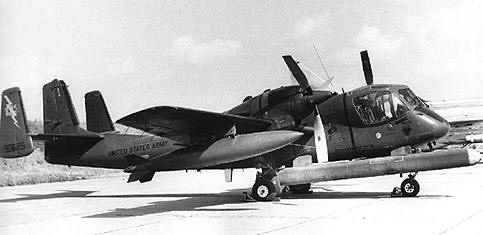
OV1D with SLAR boom on
runway
apron. |
|
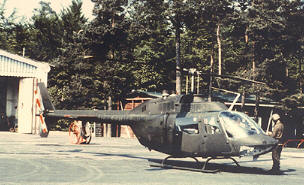
The flight strip and OH
58 at
Reiterswiesen, Bad Kissingen.
Aircraft preps for a border flight |
|
| |
|
|
|
|
| |
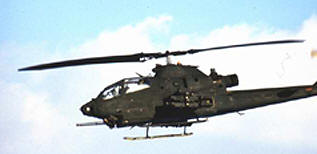
Cobra aircraft, Eaglehorse sector,
low pass. |
|
| |
|
|
|
|
| |
|
|
| |
Bundesgrenzschutz - The German Federal Border Agency |
|
| |
Return to Top
The BGS was established in 1951 under the
Interior Ministry as the western allies allowed Germany to
establish a national police force to secure borders, air and
seaports. The previous year, the new customs service had
been established, and Bundeswehr would follow in 1955. These
measures insured the sovereignty and stability of the
Federal Republic of Germany.
| |
|
|
|
|
| |
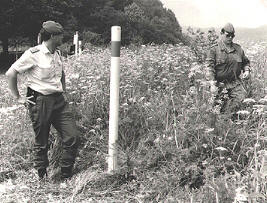
BGS Officer at left and a GAK Captain on the border.
The BGS carried side arms on patrol with machine
pistols in their vehicle. -- Ritter |
|
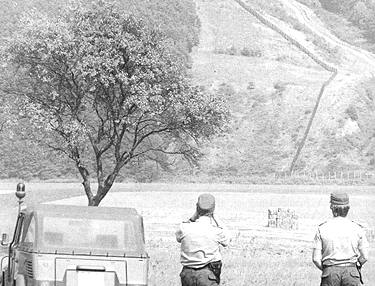
BGS patrol observes the border. --Ritter |
|
| |
|
|
|
|
The BGS evolved through the years; in addition to border
security, it assumed civil control and anti riot functions
to assist urban police, was granted police power along the
railway system and the GS9 “Special Operations“ sub unit was
created for anti terrorist missions. By 1976 it was
separated from the German draft system and became an all
volunteer police force.
The BSG routinely patrolled the border on foot, in vehicles,
from the air and staffed fixed observation points. They were
the experts in observing and cataloging the actions of the
East German Border Troops and had a complete understanding
of the barrier system. When East German engineers went into
the Spring and Summer construction phase, members of the BGS
were highly visible and would monitor the open barrier
daily. Eaglehorse troopers were very familiar with the BGS
and would exchange a friendly wave. In the late 1970's and
early 1980's, the unit at Camp Lee and the BGS would conduct
a joint patrol once per month. In the mid and late 1980's
closer coordination and more frequent joint patrols
occurred.
| |
|
|
|
|
| |
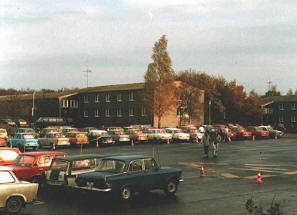
Part of the BGS Barracks at Oerlenbach in 1989. Some
of the barracks space is being used to hold refugees
from the East. --Ritter |
|
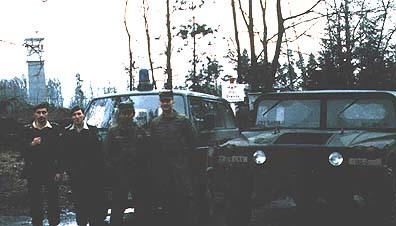
Joint US and BGS Patrol in 1988, Eaglehorse
personnel, center, CPT Dan La Vulo, Border Officer
and to right, SSG Tom Favia, Border NCO.
--Ritter |
|
| |
|
|
|
|
The BGS officers seen in the Eaglehorse sector came from
the barracks at Oerlenbach, just south of Bad Kissingen.
Their patrol responsibility ran from our northern boundary
by Melpers to well into the 2/2 ACR sector in the southeast.
Depending upon the level of activity, between 16-30 officers
deployed each day to observe. They routinely coordinated
actions with the German Customs Police, the Bavarian Border
Police and the US military. Spot reports were sent from
their helicopter patrols and when observing East German
operations such as fence construction and mine clearing. As
the BGS became aware of East German SIGINT operations, they
switched to reporting by telephone.
| |
|
|
| |
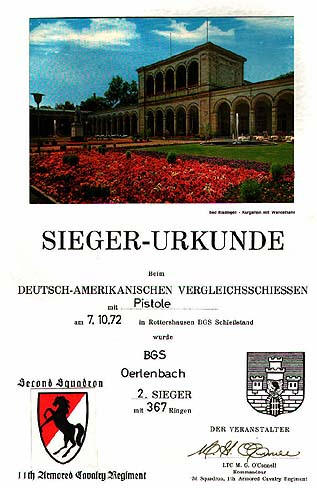
An Eaglehorse Award Certificate signed by then SCO,
LTC M.G. O'Connell, awarded to BGS personnel after
participation in a joint pistol shooting competition
at the Rottershausen range complex, not too far from
Orelenbach, SE of BK. Rottershausen, a large 3rd ID
ASP also had ranges and facilities that I believe
were jointly used by BGS and US forces. The ASP is
closed but the other areas are still in active BGS
use.
--Ritter |
|
| |
|
|
| |
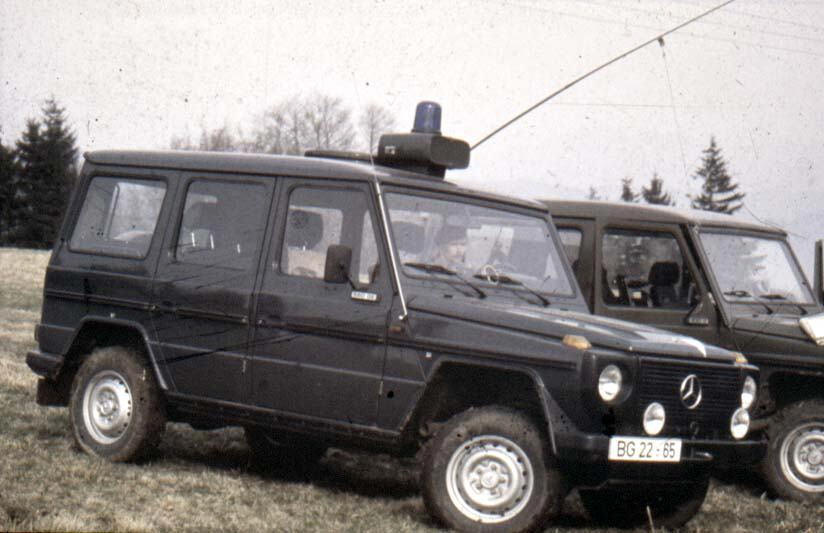
Joint BGS/US Patrol. Ritter
|
|
| |
|
|
Once the barrier system came down and Germany reunited,
the BGS absorbed some units of the former East German Border
Troops that were involved with security along the Polish and
Czech border. Other former BT units brought into the BGS
helped dismantle the barrier and mine system along the
former inner German border. In the immediate years that
followed, however, almost all former East Germans were
separated from the BGS. The BGS barracks at Oerlenbach is
still operational as a training center / police academy.
They conduct a portion of their driver's training course on
the former US airstrip at Reiterswiesen.
| |
|
|
|
|
| |
Ted Prescott |
|
| |
Here are pictures from the BGS & E
Troop tank driver training in 1984-1985 time frame.
We were at gunnery so we had the BGS come out when
we had some time off. Dieter Griebling was the
commander for the BGS at this time. |
|
| |
|
|
|
|
| |
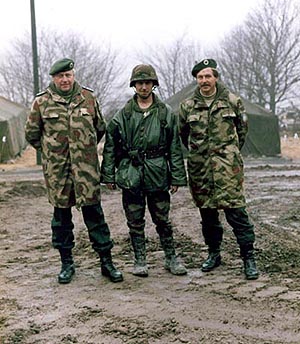 |
|
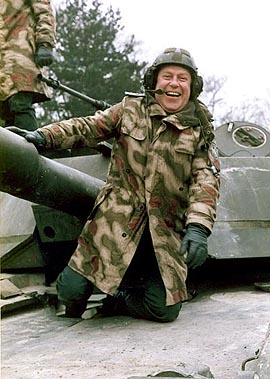 |
|
| |
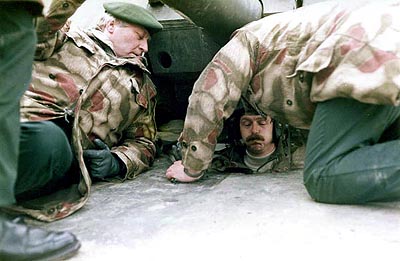 |
|
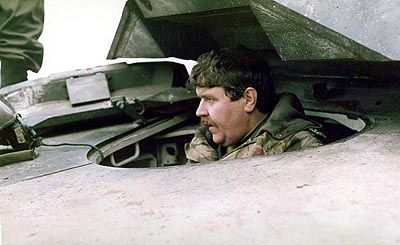 |
|
| |
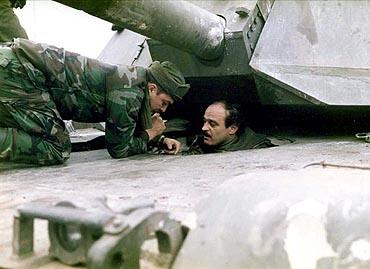 |
|
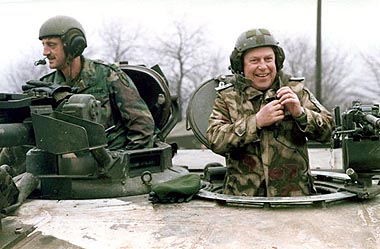 |
|
| |
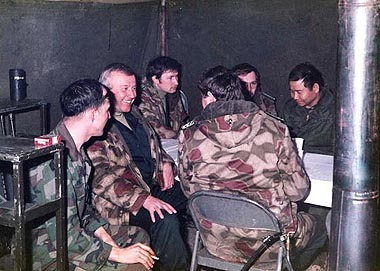 |
|
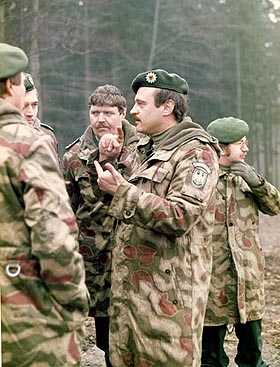 |
|
| |
|
|
|
|
|
|
|